多维数据结构与运算
Posted 山川绿水
tags:
篇首语:本文由小常识网(cha138.com)小编为大家整理,主要介绍了多维数据结构与运算相关的知识,希望对你有一定的参考价值。
数据科学技术与应用——第2章 多维数据结构与运算
2.1 多维数据对象
例题如下
例题[2-1] 创建两个一维数组风别保存学生姓名和考试科目,访问数组元素。学业水平考试涉及多门课程和多名学生,虽然课程名称、姓名的数据类型都是字符串,但是对应的现实概念却不同,需存放两个一位数组中。
>>> import numpy as np
>>> names = np.array(['王薇','肖良英','方绮雯','刘旭阳','钱易铭'])
>>> names
array(['王薇', '肖良英', '方绮雯', '刘旭阳', '钱易铭'], dtype='<U3')
>>> subjects = np.array(['Math','English','Python','Chinese','Art','Database','Physics'])
>>> subjects
array(['Math', 'English', 'Python', 'Chinese', 'Art', 'Database',
'Physics'], dtype='<U8')
>>>
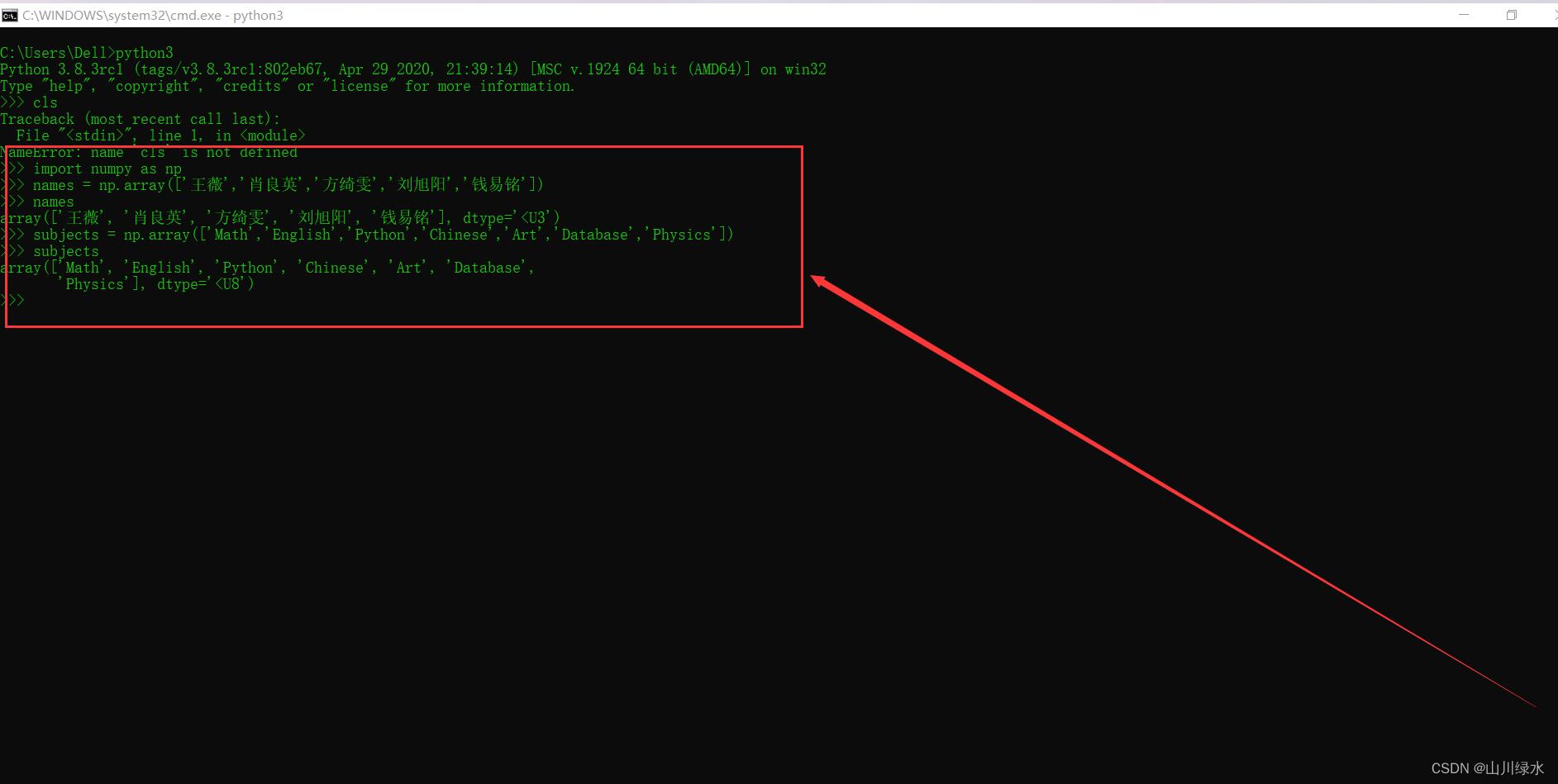
[例题2-2] 创建二维数组scores,记录names中每名学生对应subjects各门课程的考试成绩。
>>> scores = np.array([[70,85,77,90,82,84,89],[60,64,80,75,80,92,90],[90,93,88,87,86,90,91],[80,82,91,88,83,86,80],[88,72,78,90,91,73,80]])
>>> scores
array([[70, 85, 77, 90, 82, 84, 89],
[60, 64, 80, 75, 80, 92, 90],
[90, 93, 88, 87, 86, 90, 91],
[80, 82, 91, 88, 83, 86, 80],
[88, 72, 78, 90, 91, 73, 80]])
>>>
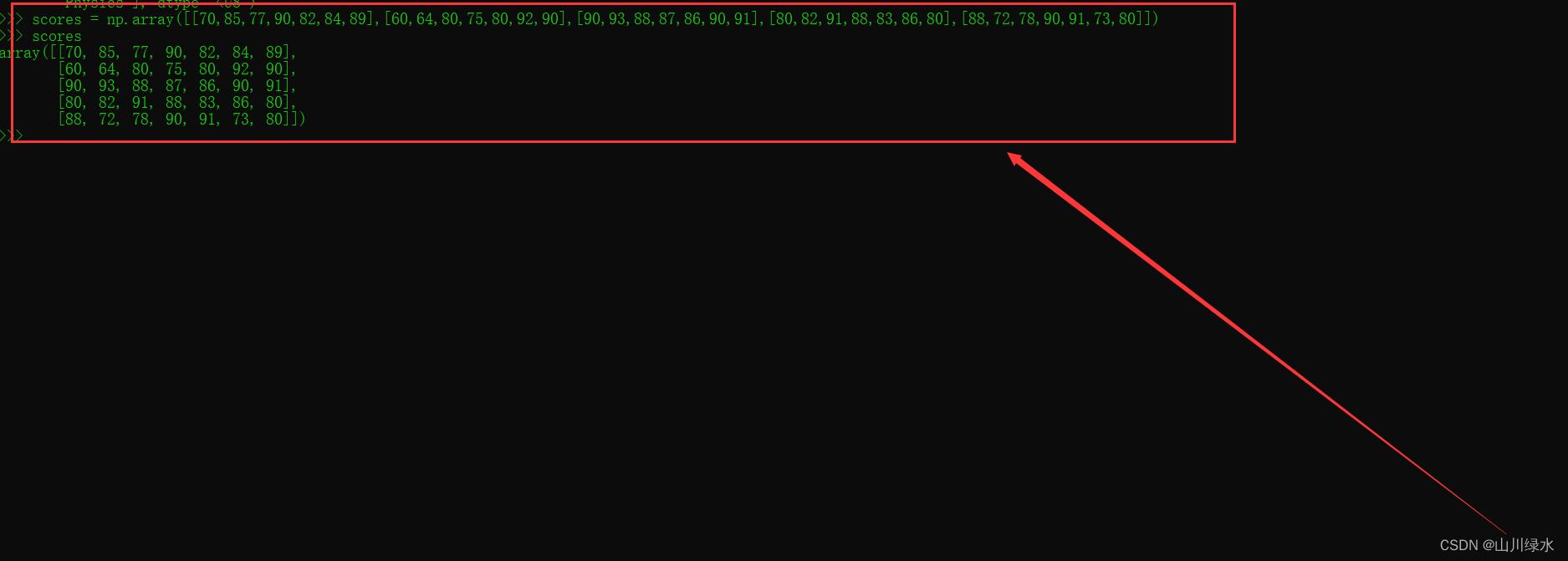
思考练习
1.一维数组访问
(1)在subjects数组中选择显示序号为:1、2、4科目的名称,使用倒序索引选择并显示names数组的“方绮雯”。
>>> subjects[[1,2,4]]
array(['English', 'Python', 'Art'], dtype='<U8')
>>> names[-3]
'方绮雯'
>>>
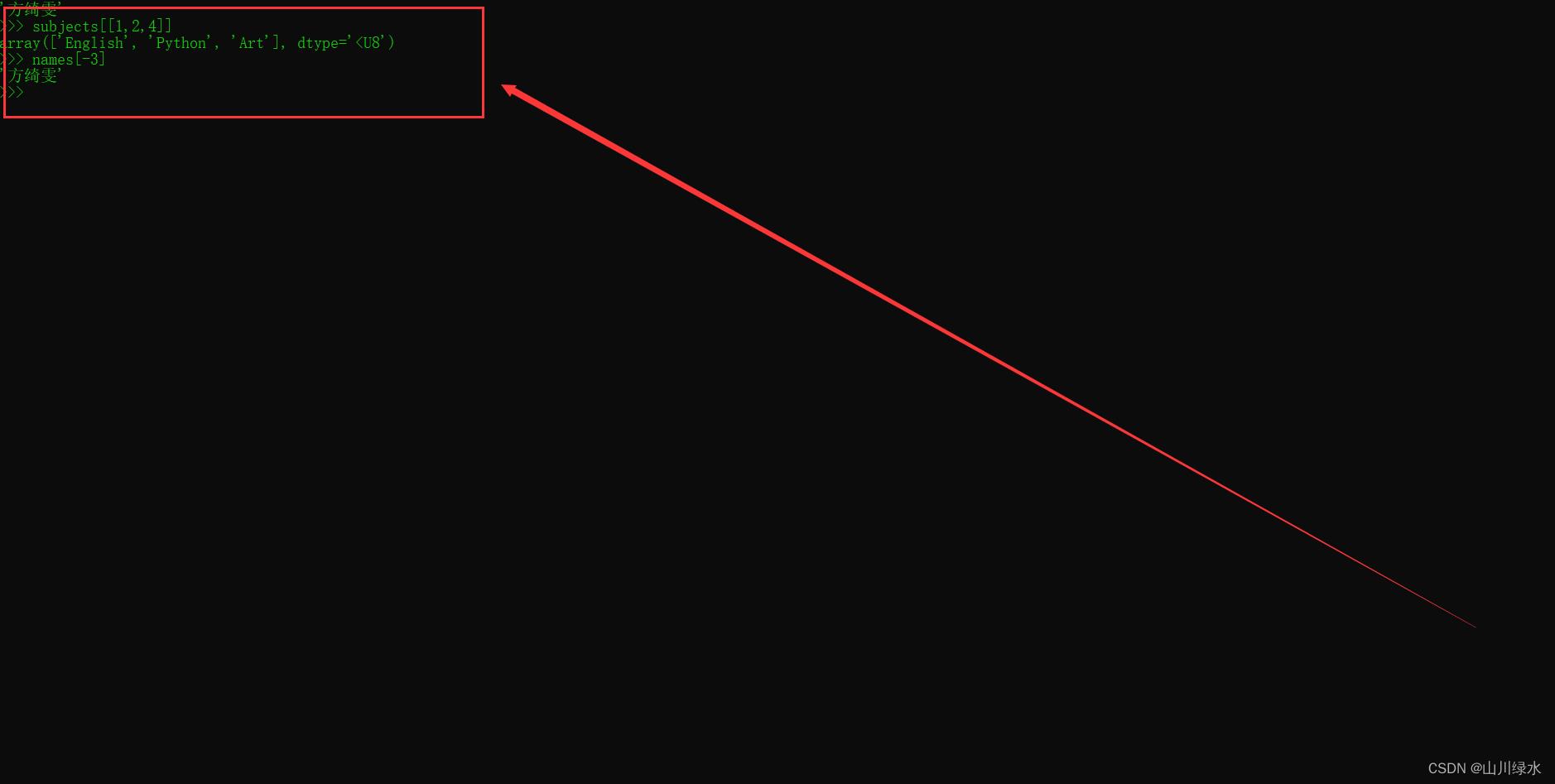
(2)选择并显示names数组从2到最后的数组元素,选择并显示subjects数组正序2~4的数组元素。
>>> names[2:]
array(['方绮雯', '刘旭阳', '钱易铭'], dtype='<U3')
>>> subjects[2:5]
array(['Python', 'Chinese', 'Art'], dtype='<U8')
>>>

(3)使用布尔条件选择并显示subjects数组中English和physics的科目名称。
>>> subjects[(subjects == 'English')|(subjects == 'Physics')]
array(['English', 'Physics'], dtype='<U8')
>>>

2.二维数组访问
(1)选择并显示scores数组的1行,4行。
>>> scores
array([[70, 85, 77, 90, 82, 84, 89],
[60, 64, 80, 75, 80, 92, 90],
[90, 93, 88, 87, 86, 90, 91],
[80, 82, 91, 88, 83, 86, 80],
[88, 72, 78, 90, 91, 73, 80]])
>>> scores[[1,4]]
array([[60, 64, 80, 75, 80, 92, 90],
[88, 72, 78, 90, 91, 73, 80]])
>>>
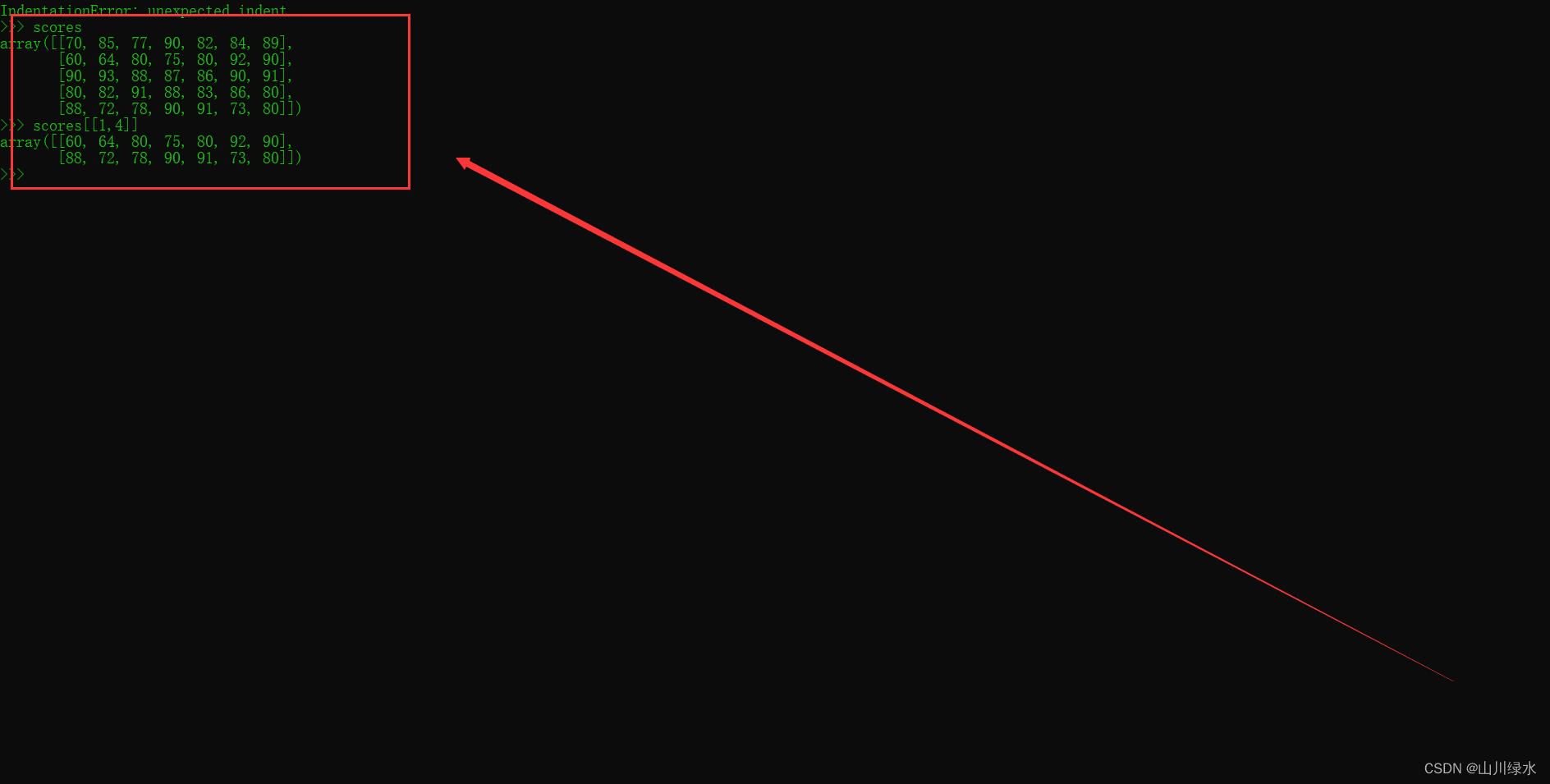
(2)选择并显示scores数组中行序为2,4学生的Math和Python成绩。
>>> subjects
array(['Math', 'English', 'Python', 'Chinese', 'Art', 'Database',
'Physics'], dtype='<U8')
>>> scores
array([[70, 85, 77, 90, 82, 84, 89],
[60, 64, 80, 75, 80, 92, 90],
[90, 93, 88, 87, 86, 90, 91],
[80, 82, 91, 88, 83, 86, 80],
[88, 72, 78, 90, 91, 73, 80]])
>>> scores[[1,3]]
array([[60, 64, 80, 75, 80, 92, 90],
[80, 82, 91, 88, 83, 86, 80]])
>>> scores[[1,3]][:,(subjects=='Math')|(subjects== 'Python')]
array([[60, 80],
[80, 91]])
>>>
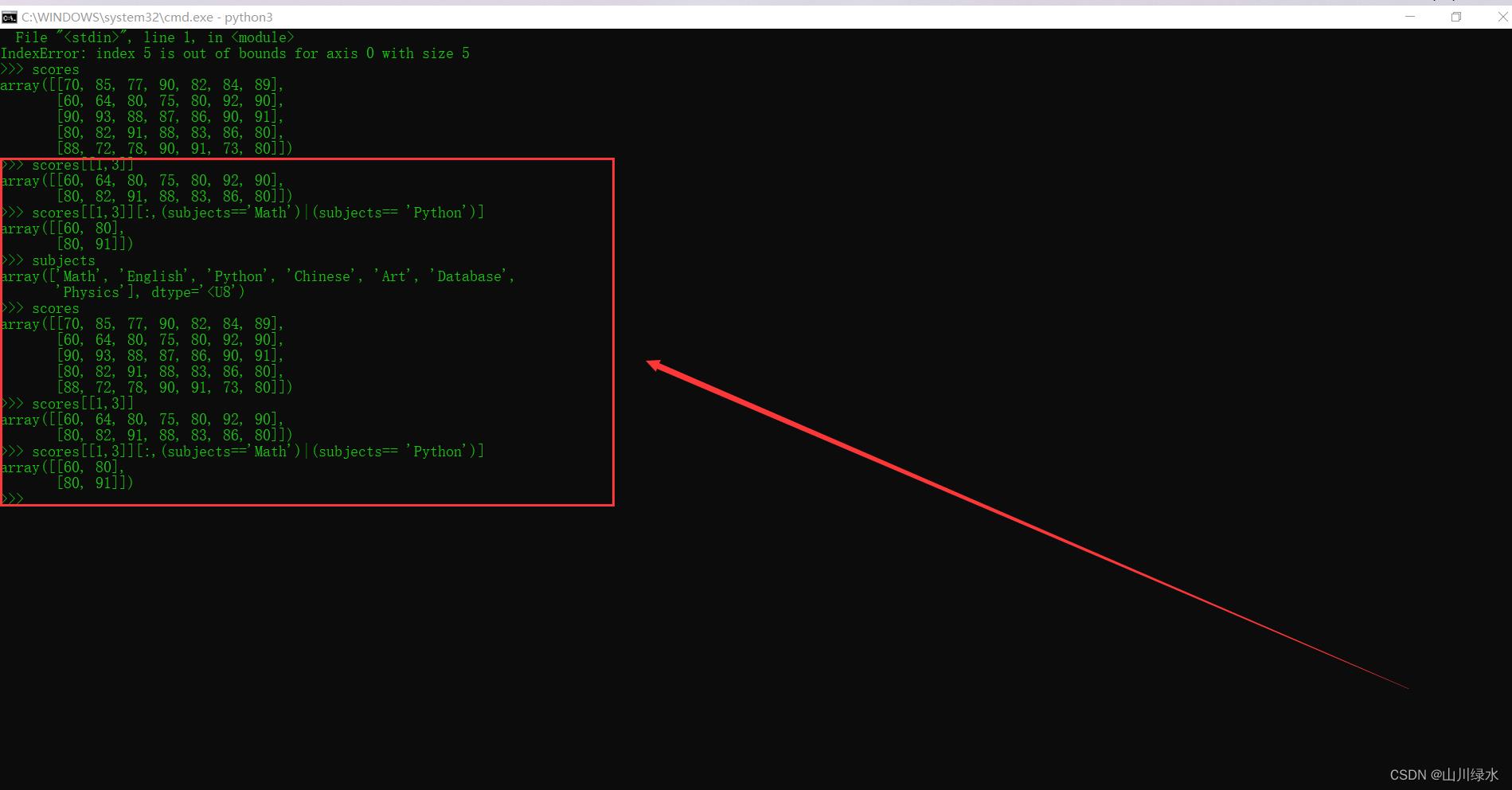
(3)选择并显示scores数组中所有学生的Math和Art成绩。
>>> subjects
array(['Math', 'English', 'Python', 'Chinese', 'Art', 'Database',
'Physics'], dtype='<U8')
>>> scores
array([[70, 85, 77, 90, 82, 84, 89],
[60, 64, 80, 75, 80, 92, 90],
[90, 93, 88, 87, 86, 90, 91],
[80, 82, 91, 88, 83, 86, 80],
[88, 72, 78, 90, 91, 73, 80]])
>>> scores[:,(subjects=='Math')|(subjects== 'Art')]
array([[70, 82],
[60, 80],
[90, 86],
[80, 83],
[88, 91]])
>>>

(4)选择并显示scores数组中“王薇”和“刘旭阳”的English和Art成绩。
>>> names
array(['王薇', '肖良英', '方绮雯', '刘旭阳', '钱易铭'], dtype='<U3')
>>> scores
array([[70, 85, 77, 90, 82, 84, 89],
[60, 64, 80, 75, 80, 92, 90],
[90, 93, 88, 87, 86, 90, 91],
[80, 82, 91, 88, 83, 86, 80],
[88, 72, 78, 90, 91, 73, 80]])
>>> subjects
array(['Math', 'English', 'Python', 'Chinese', 'Art', 'Database',
'Physics'], dtype='<U8')
>>> scores[(names == 'English')|(names == 'Art')]
array([], shape=(0, 7), dtype=int32)
>>> scores[(names == '王薇')|(names == '刘旭阳')][:,(subjects == 'English')|(subjects == 'Art')]
array([[85, 82],
[82, 83]])
>>>

3.生成有整数10~19组成的2 x 5的二维数组。
>>> np.arange(10,20).reshape(2,5)
array([[10, 11, 12, 13, 14],
[15, 16, 17, 18, 19]])
>>>
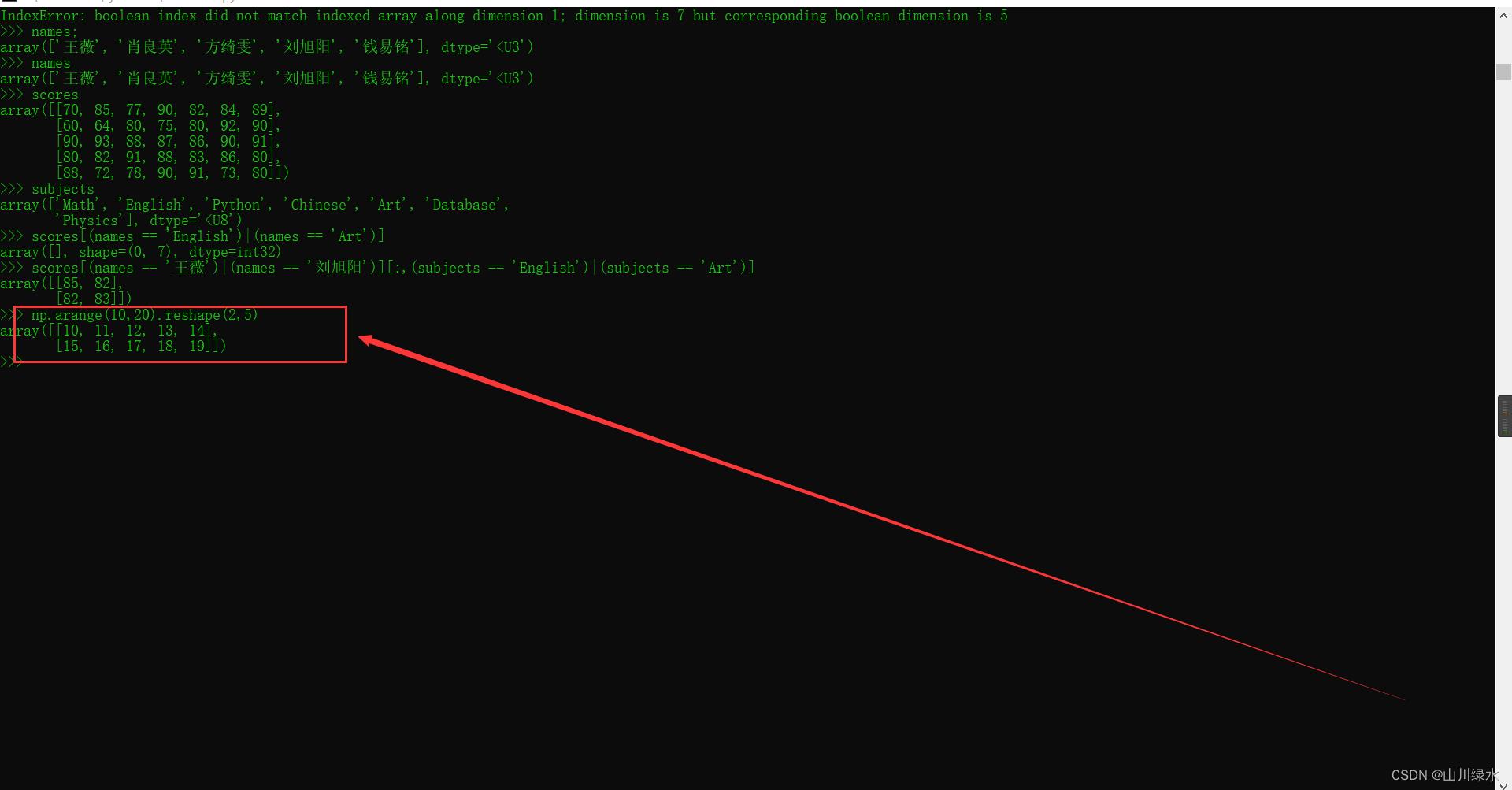
2.2 多维数组运算
例题如下
例题[2-3] 为所有学生的所有课程成绩增加5分
>>> scores
array([[70, 85, 77, 90, 82, 84, 89],
[60, 64, 80, 75, 80, 92, 90],
[90, 93, 88, 87, 86, 90, 91],
[80, 82, 91, 88, 83, 86, 80],
[88, 72, 78, 90, 91, 73, 80]])
>>> scores + 5
array([[75, 90, 82, 95, 87, 89, 94],
[65, 69, 85, 80, 85, 97, 95],
[95, 98, 93, 92, 91, 95, 96],
[85, 87, 96, 93, 88, 91, 85],
[93, 77, 83, 95, 96, 78, 85]])
>>>
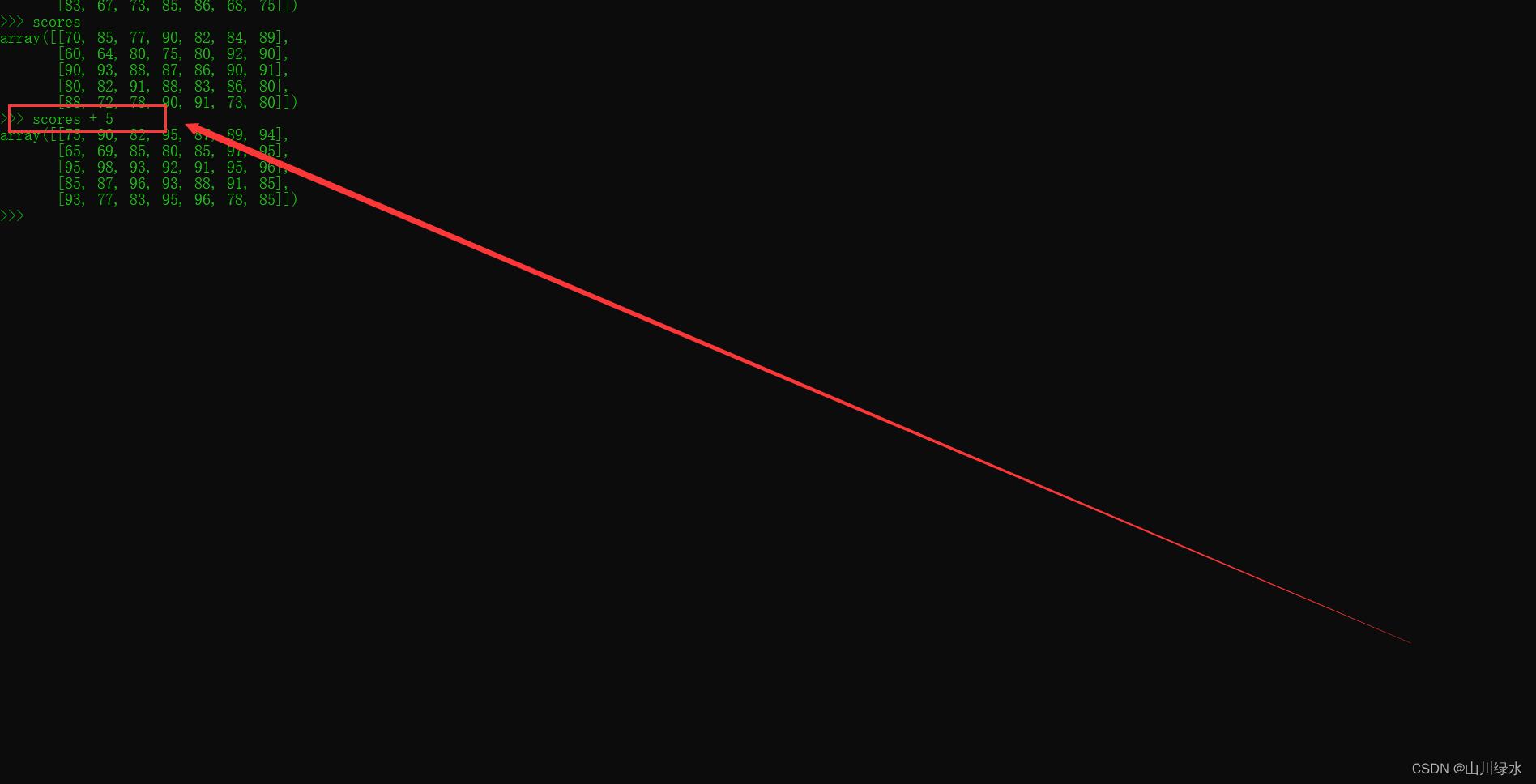
Python内部实现数组与标量相加时,使用“广播机制”先将标量5转换成元素值为5的5 x 7二维数组,再将scores和新生成的数组按位相加,等价于以下代码。
>>> scores
array([[70, 85, 77, 90, 82, 84, 89],
[60, 64, 80, 75, 80, 92, 90],
[90, 93, 88, 87, 86, 90, 91],
[80, 82, 91, 88, 83, 86, 80],
[88, 72, 78, 90, 91, 73, 80]])
>>> a = np.ones((5,7))
>>> a
array([[1., 1., 1., 1., 1., 1., 1.],
[1., 1., 1., 1., 1., 1., 1.],
[1., 1., 1., 1., 1., 1., 1.],
[1., 1., 1., 1., 1., 1., 1.],
[1., 1., 1., 1., 1., 1., 1.]])
>>> a = np.ones((5,7))*5
>>> a
array([[5., 5., 5., 5., 5., 5., 5.],
[5., 5., 5., 5., 5., 5., 5.],
[5., 5., 5., 5., 5., 5., 5.],
[5., 5., 5., 5., 5., 5., 5.],
[5., 5., 5., 5., 5., 5., 5.]])
>>> scores + a
array([[75., 90., 82., 95., 87., 89., 94.],
[65., 69., 85., 80., 85., 97., 95.],
[95., 98., 93., 92., 91., 95., 96.],
[85., 87., 96., 93., 88., 91., 85.],
[93., 77., 83., 95., 96., 78., 85.]])
>>>
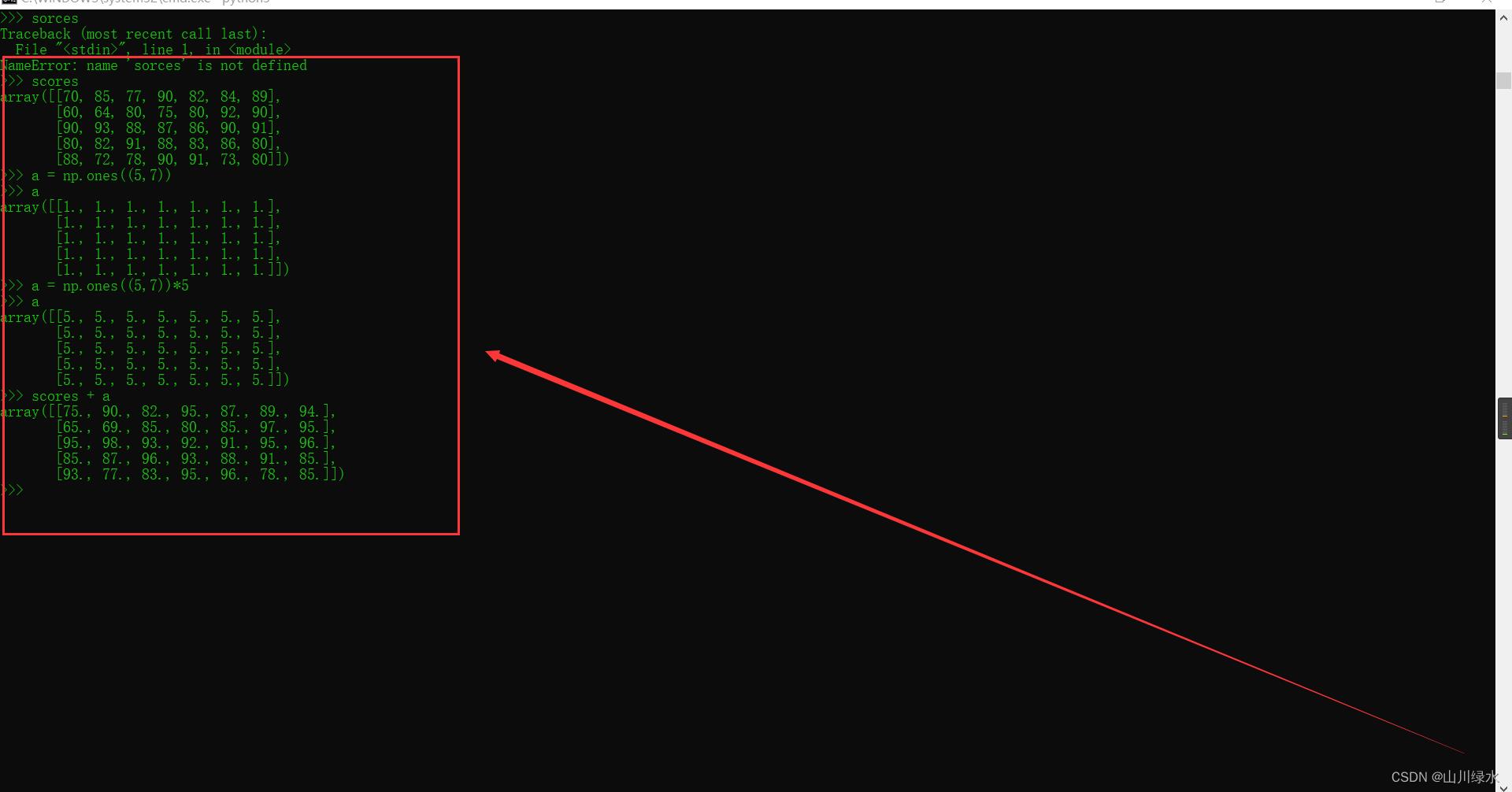
例题[2-4] 首先创建一维数组存放不同科目增加分数,然后将其和scores相加。
>>> bonus = np.array([3,4,5,3,6,7,2])
>>> scores + bonus
array([[73, 89, 82, 93, 88, 91, 91],
[63, 68, 85, 78, 86, 99, 92],
[93, 97, 93, 90, 92, 97, 93],
[83, 86, 96, 91, 89, 93, 82],
[91, 76, 83, 93, 97, 80, 82]])
>>>

例题[2-5]将学生的考试成绩转换为整数形式的十分制分数
>>> np.floor(scores/10)
array([[7., 8., 7., 9., 8., 8., 8.],
[6., 6., 8., 7., 8., 9., 9.],
[9., 9., 8., 8., 8., 9., 9.],
[8., 8., 9., 8., 8., 8., 8.],
[8., 7., 7., 9., 9., 7., 8.]])
>>>
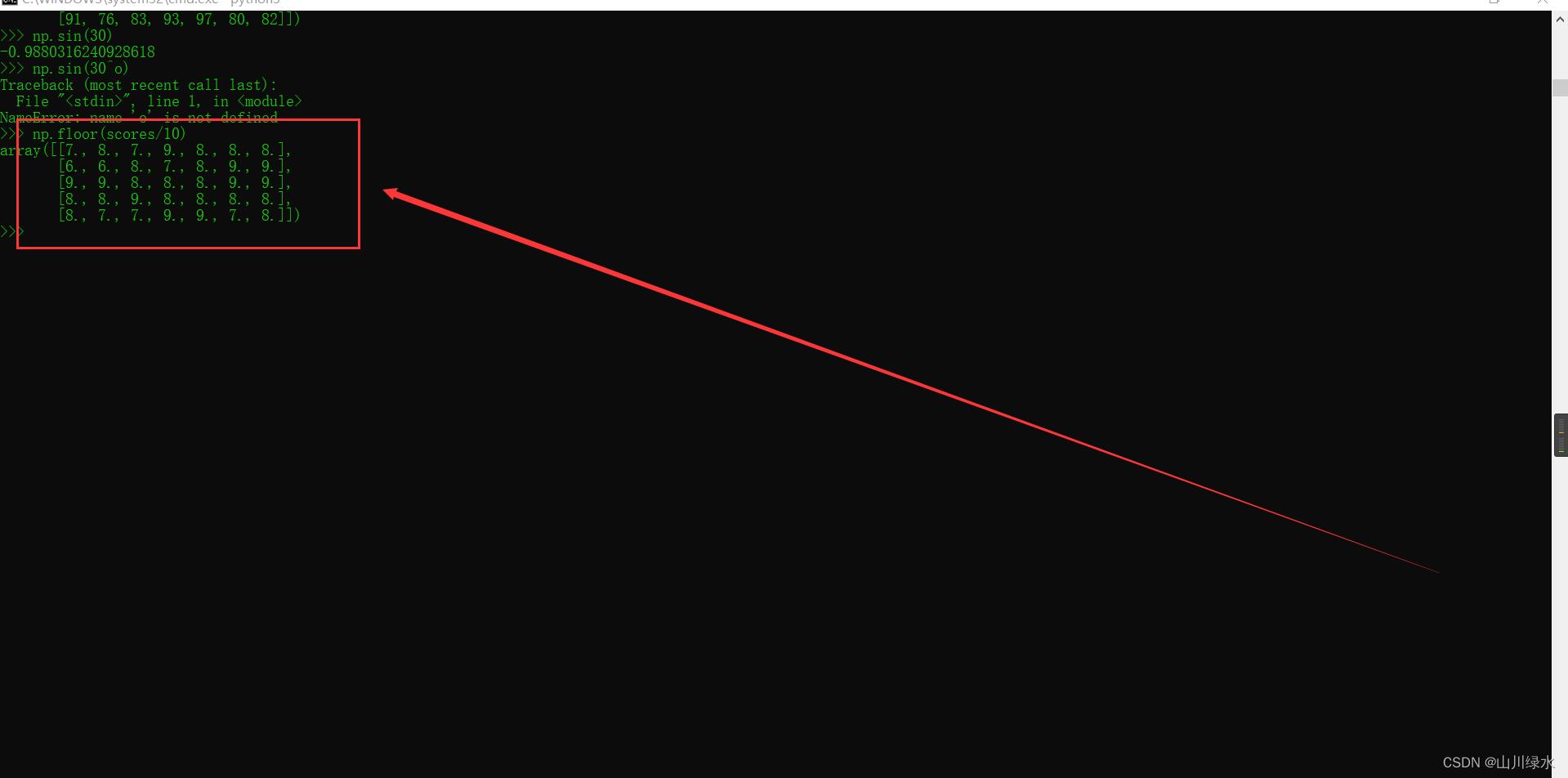
例题[2-6] 使用subtract()给每个学生的分数减去3分
>>> np.subtract(scores,3)
array([[67, 82, 74, 87, 79, 81, 86],
[57, 61, 77, 72, 77, 89, 87],
[87, 90, 85, 84, 83, 87, 88],
[77, 79, 88, 85, 80, 83, 77],
[85, 69, 75, 87, 88, 70, 77]])
>>>

例题[2-7] 按照分析目标使用聚合函数进行统计。
(1)统计不同科目的成绩总分。
当axis=0时,按列求和;当axis=1时,按行求和
>>> scores
array([[70, 85, 77, 90, 82, 84, 89],
[60, 64, 80, 75, 80, 92, 90],
[90, 93, 88, 87, 86, 90, 91],
[80, 82, 91, 88, 83, 86, 80],
[88, 72, 78, 90, 91, 73, 80]])
>>> scores.sum(axis = 0)
array([388, 396, 414, 430, 422, 425, 430])
>>> scores.sum(axis = 1)
array([577, 541, 625, 590, 572])
>>>
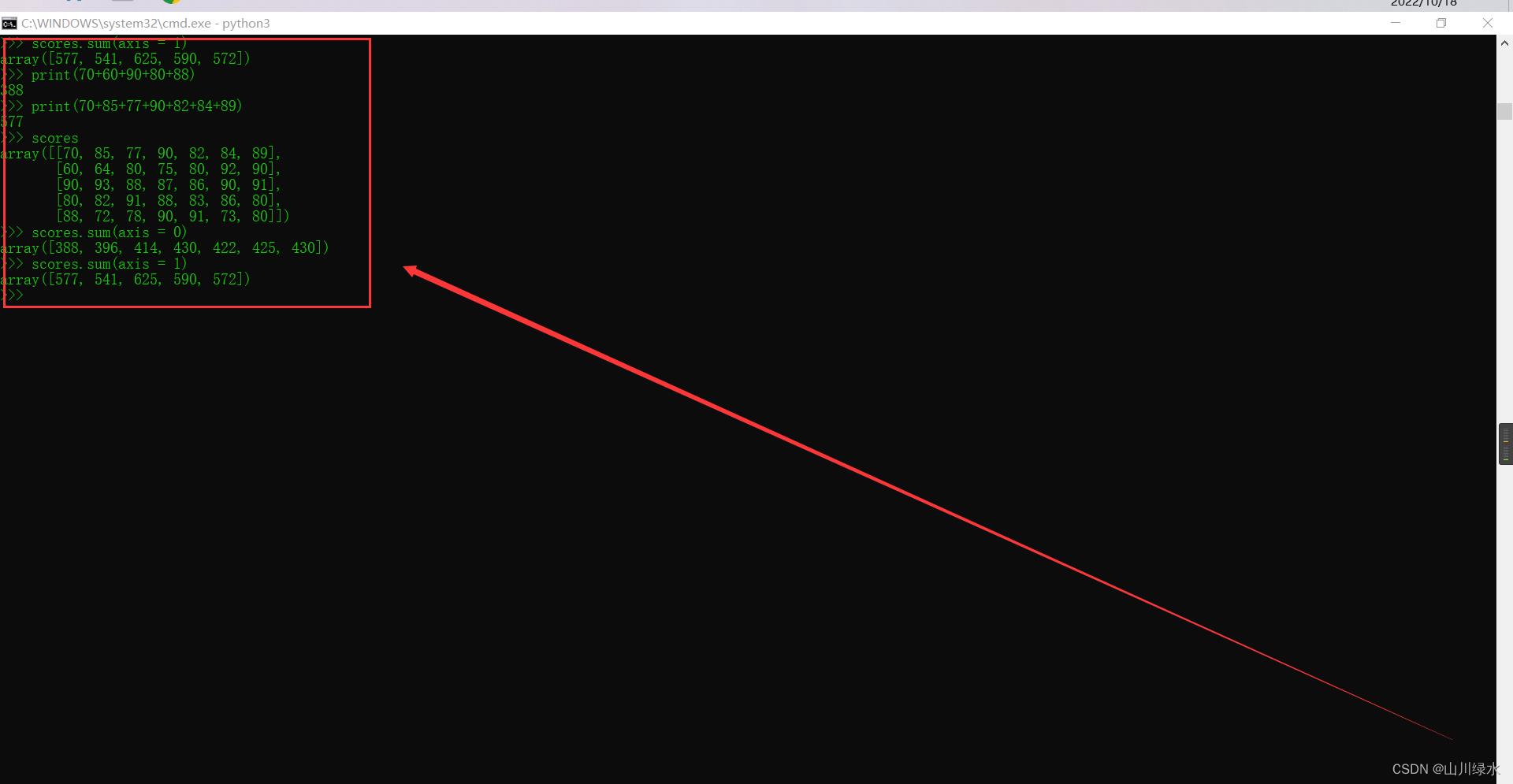
(2)求王薇所有课程成绩的平均分
>>> scores[names == '王薇'].mean()
82.42857142857143
>>>
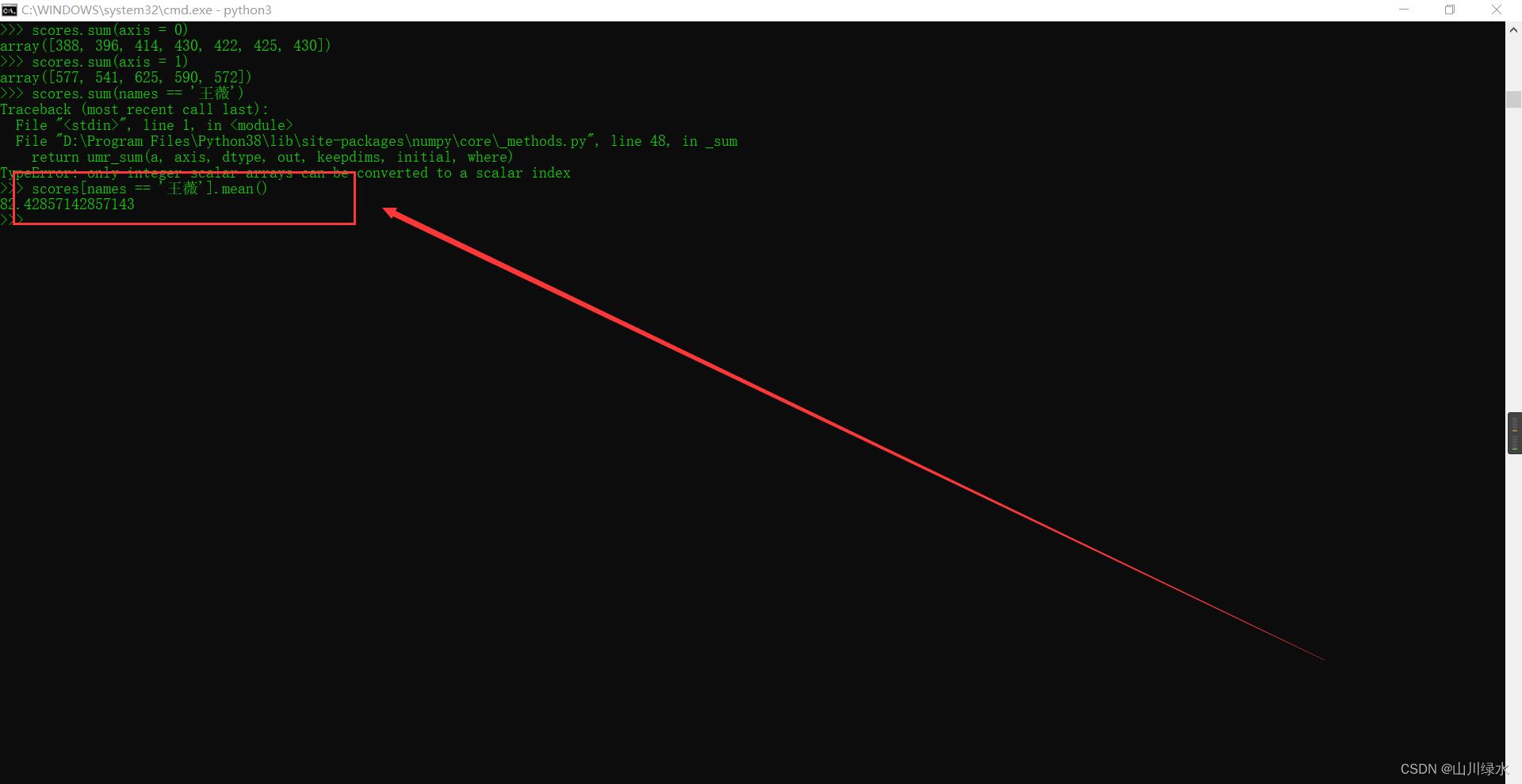
(3)查询英语考试成绩最高的学生姓名。
>>> names[scores[:,subjects == 'English'].argmax()]
'方绮雯'
>>>
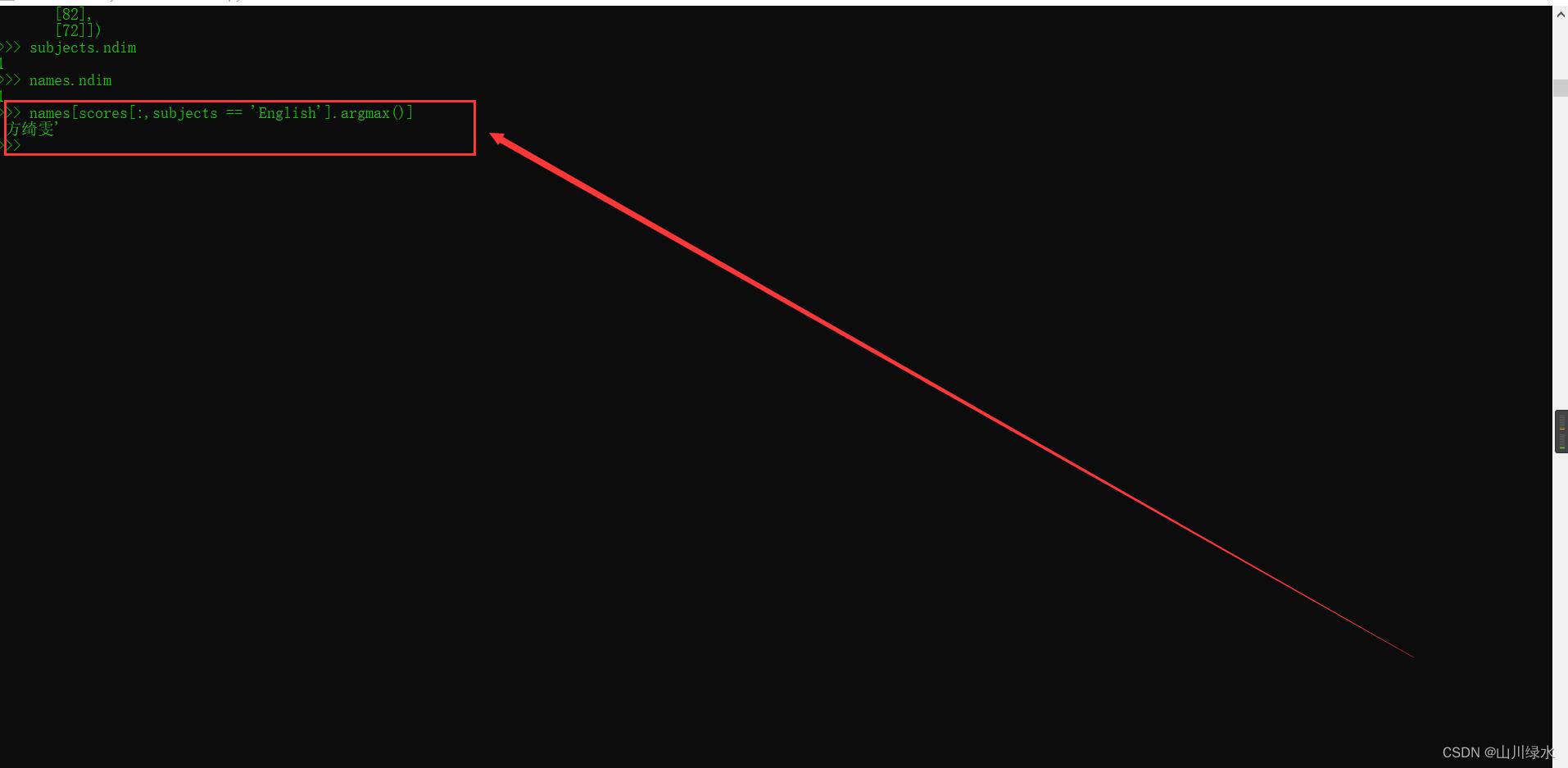
例题[2-8] 生成由10个随机整数组成的一维数组,整数的取值范围为0~5
>>> np.random.randint(0,6,10)
array([2, 0, 0, 1, 3, 4, 4, 3, 5, 4])
>>>
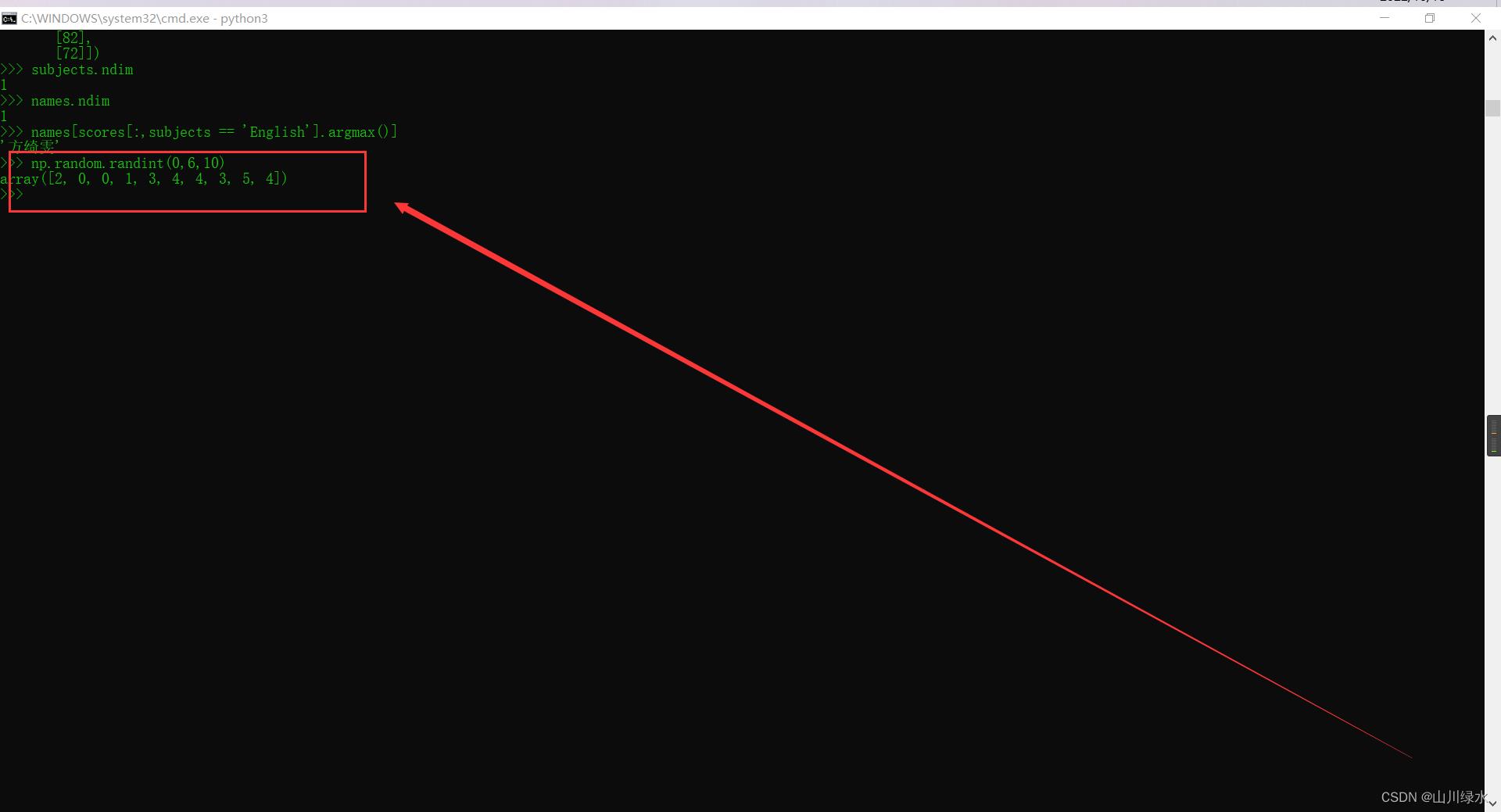
randint(start,end,size)生成元素值从start到end-1范围内的整数数组,数组的大小由参数size对应的元组给出。数组的元素值随机生成,start到end-1范围内各整数出现的概率相等。
生成5x6的二维随机整数,随机数的数值是0或1.
>>> np.random.randint(0,2,size=(5,6))
array([[0, 1, 0, 0, 1, 1],
[1, 0, 1, 0, 1, 1],
[1, 1, 0, 1, 0, 0],
[0, 0, 0, 0, 0, 0],
[0, 0, 0, 0, 0, 0]])
>>>
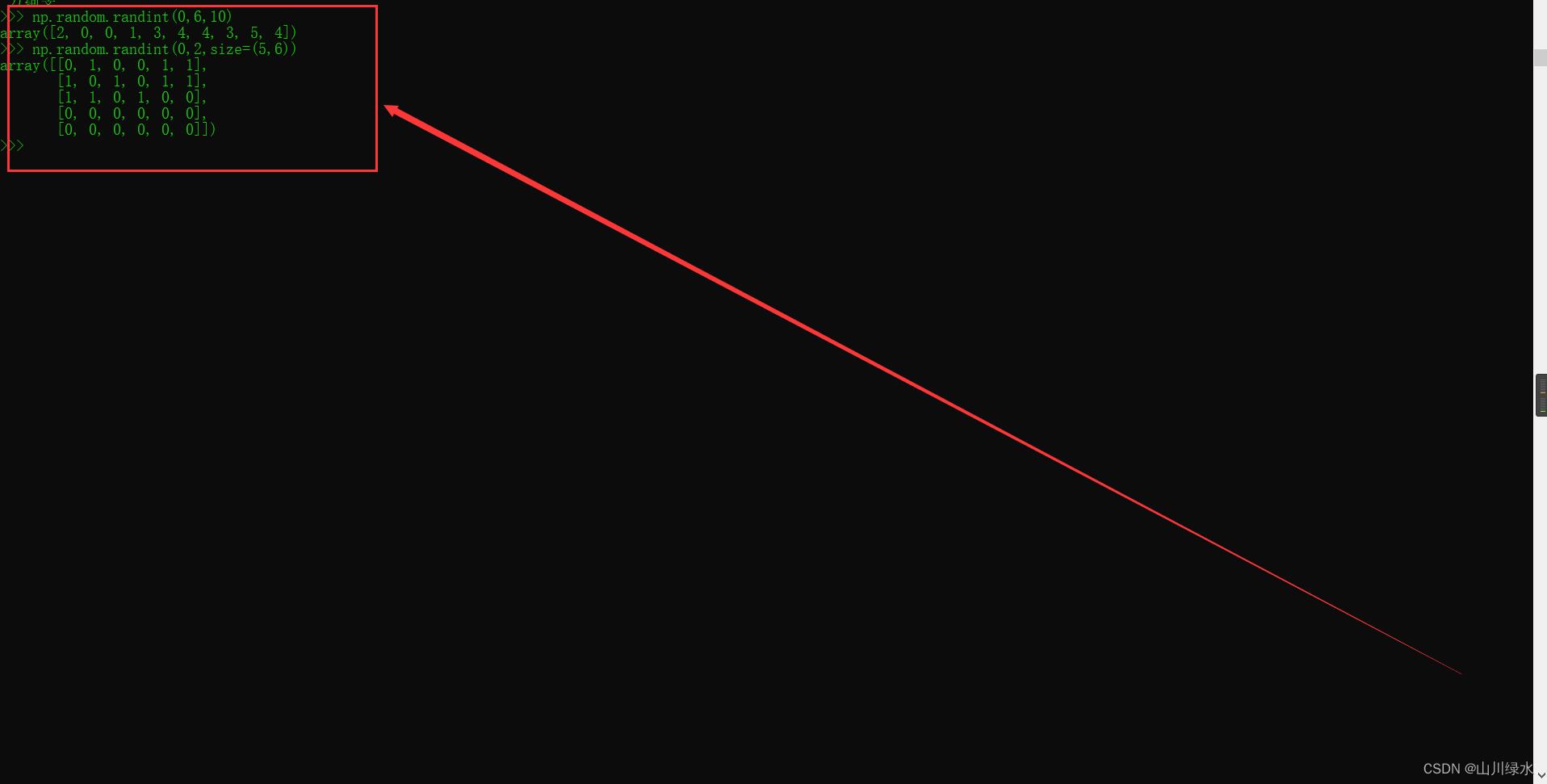
例题[2-9] 生成均值为0、方差为1服从正态分布的4 x 5二维数组。
>>> np.random.normal(0,1,size=(4,5))
array([[ 0.04111635, 0.33721789, -0.94626777, -0.37308784, 1.03114603],
[ 1.08395911, -0.94781292, 1.26963415, -0.41418987, 0.86087328],
[ 1.67631503, 0.50088484, -0.23439744, -0.16995821, -0.4845101 ],
[ 0.95059664, 0.88885886, 0.61801912, 0.34760242, -0.89209873]])
>>>

思考与练习
1.将scores数组中所有学生的英语成绩减去3分并显示
>>> scores
array([[70, 85, 77, 90, 82, 84, 89],
[60, 64, 80, 75, 80, 92, 90],
[90, 93, 88, 87, 86, 90, 91],
[80, 82, 91, 88, 83, 86, 80],
[88, 72, 78, 90, 91, 73, 80]])
>>> subjects
array(['Math', 'English', 'Python', 'Chinese', 'Art', 'Database',
'Physics'], dtype='<U8')
>>> scores[:,subjects='English']
File "<stdin>", line 1
scores[:,subjects='English']
^
SyntaxError: invalid syntax
>>> scores[:,subjects == 'English']
array([[85],
[64],
[93],
[82],
[72]])
>>> scores[:,subjects == 'English'] - 3
array([[82],
[61],
[90],
[79],
[69]])
>>>

2.统计scores数组中每名学生所有科目的平均分并显示
>>> scores.mean(axis = 1)
array([82.42857143, 77.28571429, 89.28571429, 84.28571429, 81.71428571])
>>> x = scores.mean(axis = 1) #按行求平均数
>>>> print(x[0])
82.42857142857143
>>> print("1",x[0])
1 82.42857142857143
>>> print(names[0],x[0])
王薇 82.42857142857143
>>> print(names[0],"平均分",x[0])
王薇 平均分 82.42857142857143
>>> names
array(['王薇', '肖良英', '方绮雯', '刘旭阳', '钱易铭'], dtype='<U3')
>>> for i in range(0,5):
... print(i)
File "<stdin>", line 2
print(i)
^
IndentationError: expected an indented block
>>> for i in range(0,5):
... print(i)
...
0
1
2
3
4
>>> for i in range(0,5):
... print(names[i],"平均分",x[i])
...
王薇 平均分 82.42857142857143
肖良英 平均分 77.28571428571429
方绮雯 平均分 89.28571428571429
刘旭阳 平均分 84.28571428571429
钱易铭 平均分 81.71428571428571
>>>

3.使用随机函数生成[-1,1]之间服从均匀分布的3 x 4的二维数组,并计算所有元素的和
>>> temp = np.random.randint(-1,2,size=(3,4))
>>> temp
array([[ 0, -1, -1, -1],
[-1, -1, 1, -1],
[ 0, 0, -1, 0]])
>>> temp.sum()
-6
>>>
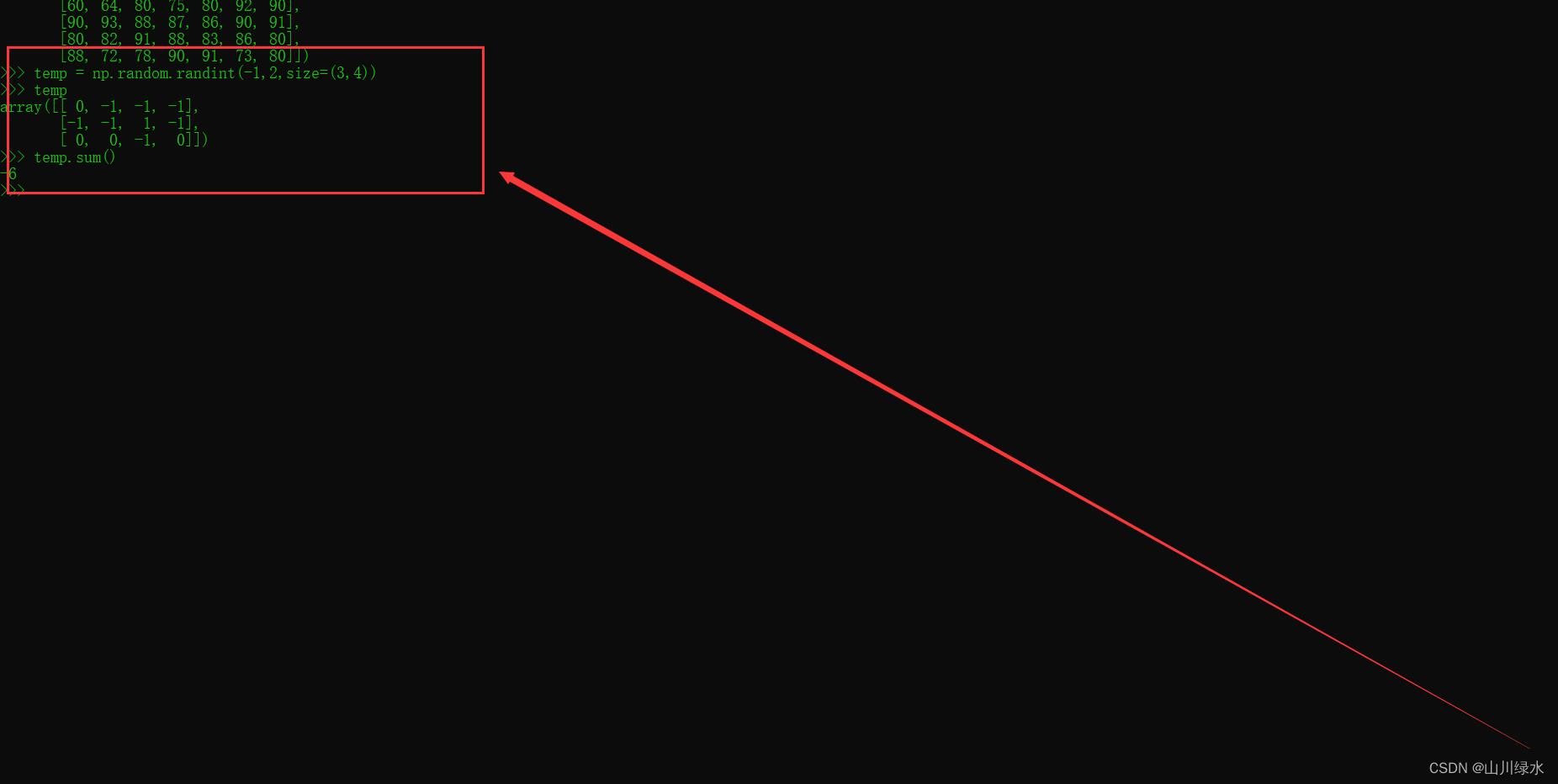
2.3案例:随机游走轨迹模拟
1.模拟生成每步移动方向
假设某次随机游走了10步,用randint()随机生成每步移动的方向,可以使用一个2 x 10的二维数组记录结果。
>>> steps = 10
>>> import numpy as np
>>> randwlk = np.random.randint(0,2,size = (2,steps))
>>> randwlk
array([[1, 1, 0, 0, 0, 0, 0, 1, 0, 0],
[1, 0, 0, 1, 1, 0, 1, 1, 0, 0]])
>>>

Numpy提供where(condition[,x,y])实现数组元素的条件赋值,参数condition是条件表达式,如果condition结果为True,返回x,否则返回y。x、y可以是数组,也可以是标量。
>>> randwlk = np.where(randwlk>0,1,-1)
>>> randwlk
array([[ 1, 1, -1, -1, -1, -1, -1, 1, -1, -1],
[ 1, -1, -1, 1, 1, -1, 1, 1, -1, -1]])
>>>
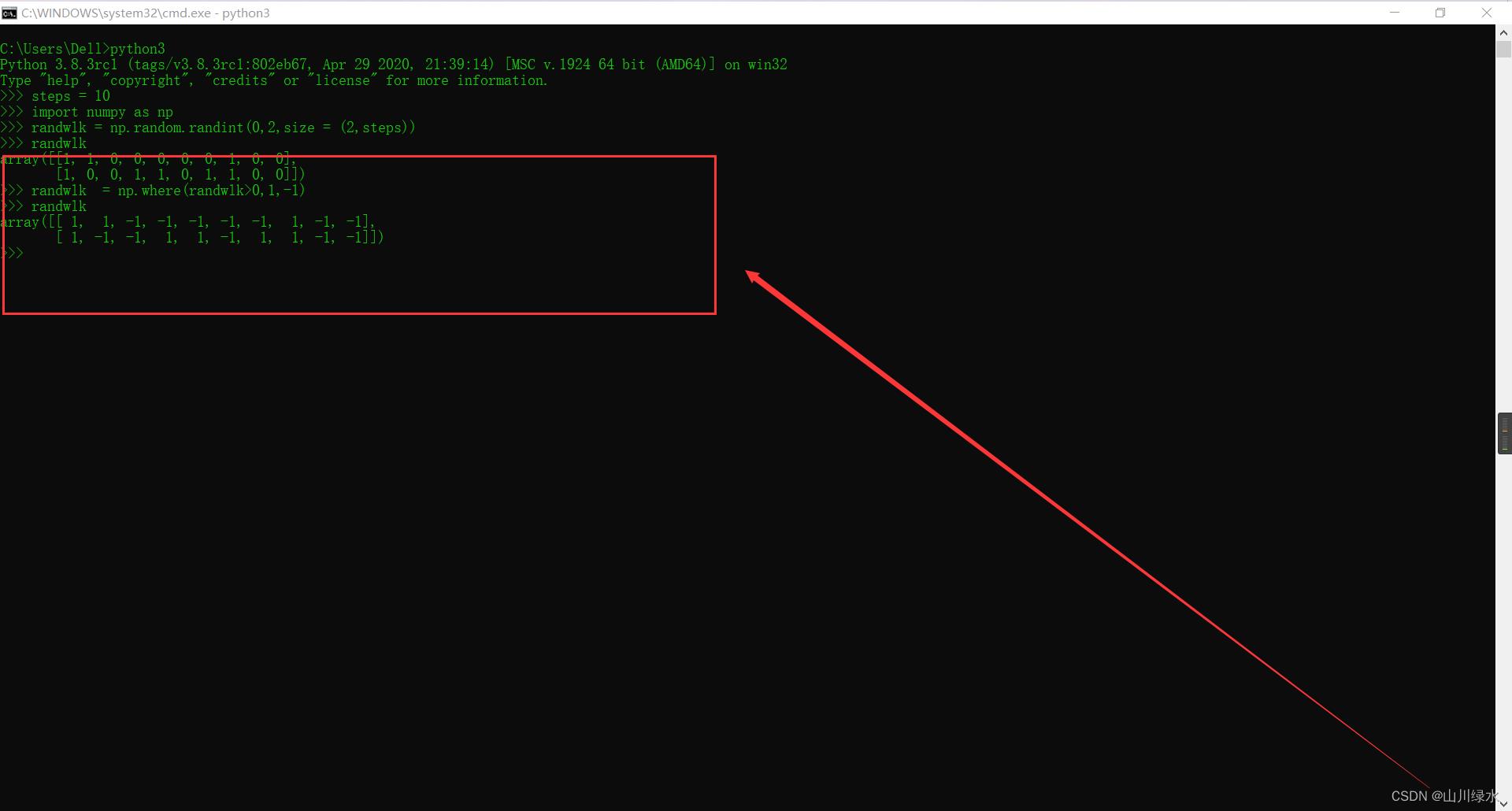
2.计算每步移动后的位置
rndwlk记录了物体每步沿着x轴,y轴移动的方向,计算第i步所处的位置只需分别累计从第1步到第i步沿x轴、y轴移动的单位总和即可。使用ndarray对象的聚合函数cumsum()就可以实现此功能。
>>> position = randwlk.cumsum(axis = 1)
>>> position
array([[ 1, 2, 1, 0, -1, -2, -3, -2, -3, -4],
[ 1, 0, -1, 0, 1, 0, 1, 2, 1, 0]])
>>>
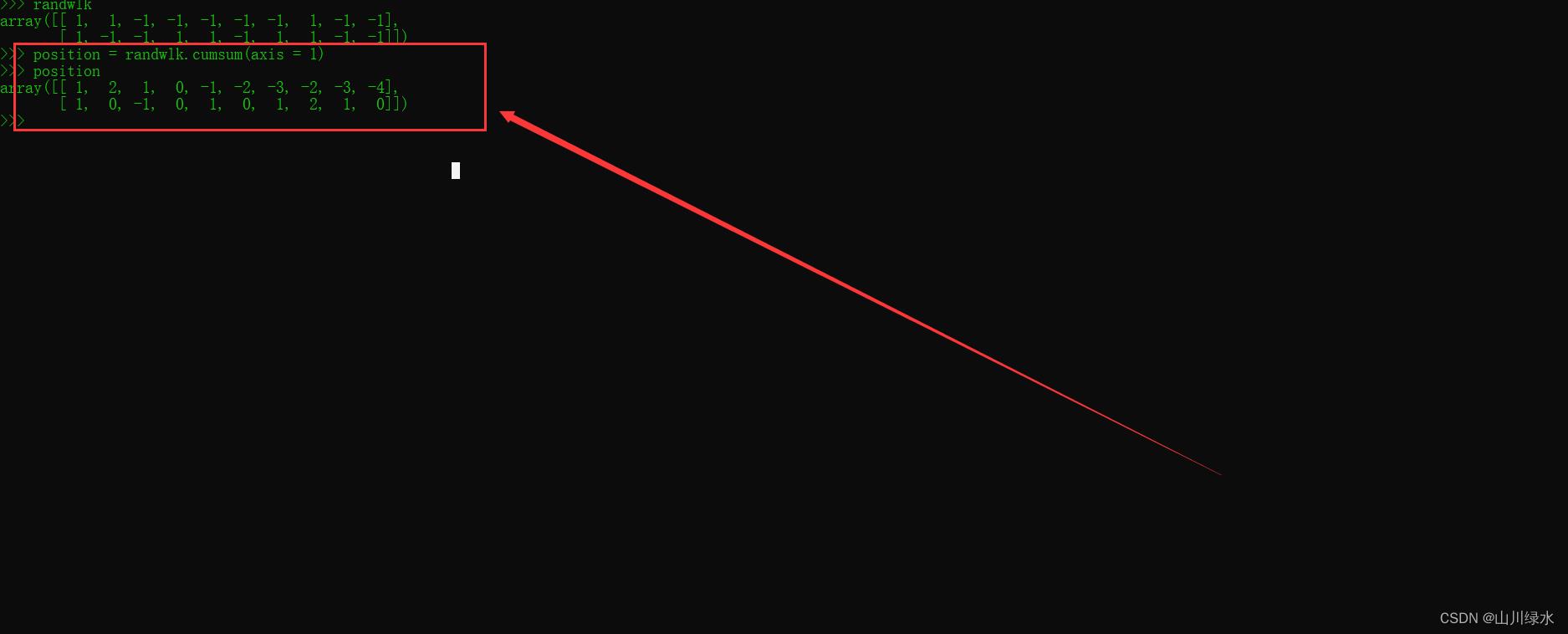
3.计算每步移动后与原点的距离
利用算数运算符和通用函数,可以算出物体在每步移动后与原点的距离。若计算得到浮点数位数太长,则可以使用np.set_printoptions()设置现实的小数位数。
>>> dists = np.sqrt(position[0]**2 + position[1]**2)
>>> dists
array([1.41421356, 2. , 1.41421356, 0. , 1.41421356,
2. , 3.16227766, 2.82842712, 3.16227766, 4. ])
>>> np.set_printoptions(precision = 4)
>>> dists
array([1.4142, 2. , 1.4142, 0. , 1.4142, 2. , 3.1623, 2.8284,
3.1623, 4. ])
>>>

对数组dists统计物体与原点距离的最大值、最小值和平均值。
>>> dists.max()
4.0
>>> dists.min()
0.0
>>> dists.mean()
2.1395623132202237
>>>

统计物体随机游走过程中与原点的距离大于平均距离的次数
>>> (dists>dists.mean()).sum()
4
>>>

思考与练习
1.将随机游走的步数增加到100步,计算物体最终与原点的距离。
>>> step = 100
>>> randwlk = np.random.randint(0,2,size = (2,step))
>>> randwlk
array([[0, 1, 0, 1, 1, 1, 0, 1, 1, 1, 1, 1, 0, 1, 0, 1, 0, 1, 1, 0, 0, 0,
0, 0, 1, 0, 1, 0, 1, 1, 1, 0, 0, 0, 1, 1, 1, 1, 1, 1, 0, 0, 1, 1,
0, 0, 1, 1, 0, 0, 1, 1, 1, 1, 0, 0, 1, 0, 1, 1, 1, 0, 0, 1, 1, 1,
1, 1, 0, 1, 0, 1, 0, 0, 1, 1, 1, 0, 1, 1, 0, 0, 0, 1, 0, 0, 1, 1,
1, 1, 1, 1, 0, 1, 0, 1, 0, 0, 1, 1],
[0, 1, 1, 1, 0, 0, 1, 0, 0, 0, 1, 1, 1, 1, 1, 1, 0, 1, 0, 0, 0, 0,
0, 1, 0, 1, 1, 0, 0, 0, 0, 1, 1, 0, 0, 0, 0, 1, 0, 0, 1, 1, 0, 1,
1, 1, 1, 1, 0, 1, 0, 1, 0, 1, 1, 0, 1, 1, 1, 1, 0, 0, 0, 1, 0, 0,
1, 0, 1, 1, 1, 1, 1, 0, 1, 1, 1, 0, 0, 1, 1, 0, 0, 1, 1, 0, 1, 0,
0, 0, 0, 0, 0, 1, 1, 0, 1, 1, 0, 1]])
>>> randwlk = np.where(randwlk>0,1,-1)
>>> randwlk
array([[-1, 1, -1, 1, 1, 1, -1, 1, 1, 1, 1, 1, -1, 1, -1, 1,
-1, 1, 1, -1, -1, -1, -1, -1, 1, -1, 1, -1, 1, 1, 1, -1,
-1, -1, 1, 1, 1, 1, 1, 1, -1, -1, 1, 1, -1, -1, 1, 1,
-1, -1, 1, 1, 1, 1, -1, -1, 1, -1, 1, 1, 1, -1, -1, 1,
1, 1, 1, 1, -1, 1, -1, 1, -1, -1, 1, 1, 1, -1, 1, 1,
-1, -1, -1, 1, -1, -1, 1, 1, 1, 1, 1, 1, -1, 1, -1, 1,
-1, -1, 1, 1],
[-1, 1, 1, 1, -1, -1, 1, -1, -1, -1, 1, 1, 1, 1, 1, 1,
-1, 1, -1, -1, -1, -1, -1, 1, -1, 1, 1, -1, -1, -1, -1, 1,
1, -1, -1, -1, -1, 1, -1, -1, 1, 1, -1, 1, 1, 1, 1, 1,
-1, 1, -1, 1, -1, 1, 1, -1, 1, 1, 1, 1, -1, -1, -1, 1,
-1, -1, 1, -1, 1, 1, 1, 1, 1, -1, 1, 1, 1, -1, -1, 1,
1, -1, -1, 1, 1, -1, 1, -1, -1, -1, -1, -1, -1, 1, 1, -1,
1, 1, -1, 1]])
>>> position = randwlk.cusum(axis = 1)
Traceback (most recent call last):
File "<stdin>", line 1, in <module>
AttributeError: 'numpy.ndarray' object has no attribute 'cusum'
>>> position = randwlk.cumsum(axis = 1)
>>> position
array([[-1, 0, -1, 0, 1, 2, 1, 2, 3, 4, 5, 6, 5, 6, 5, 6,
5, 6, 7, 6, 5, 4, 3, 2, 3, 2, 3, 2, 3, 4, 5, 4,
3, 2, 3, 4, 5, 6, 7, 8, 7, 6, 7, 8, 7, 6, 7, 8,
7, 6, 7, 8, 9, 10, 9, 8, 9, 8, 9, 10, 11, 10, 9, 10,
11, 12, 13, 14, 13, 14, 13, 14, 13, 12, 13, 14, 15, 14, 15, 16,
15, 14, 13, 14, 13, 12, 13, 14, 15, 16, 17, 18, 17, 18, 17, 18,
17, 16, 17, 18],
[-1, 0, 1, 2, 1, 0, 1, 0, -1, -2, -1, 0, 1, 2, 3, 4,
3, 4, 3, 2, 1, 0, -1, 0, -1, 0, 1, 0, -1, -2, -3, -2,
-1, -2, -3, -4, -5, -4, -5, -6, -5, -4, -5, -4, -3, -2, -1, 0,
-1, 0, -1, 0, -1, 0, 1, 0, 1, 2, 3, 4, 3, 2, 1, 2,
1, 0, 1, 0, 1, 2, 3, 4, 5, 4, 5, 6, 7, 6, 5, 6,
7, 6, 5, 6, 7, 6, 7, 6, 5, 4, 3, 2, 1, 2, 3, 2,
3, 4, 3, 4]])
>>> dists = np.sqrt(position[0]**2 + positrion[1]**2)
Traceback (most recent call last):
File "<stdin>", line 1, in <module>
NameError: name 'positrion' is not defined
>>> dists = np.sqrt(position[0]**2 + position[1]**2)
>>> dists
array([ 1.4142, 0. , 1.4142, 2. , 1.4142, 2. , 1.4142,
2. , 3.1623, 4.4721, 5.099 , 6. , 5.099 , 6.3246,
5.831 , 7.2111, 5.831 , 7.2111, 7.6158, 6.3246, 5.099 ,
4. , 3.1623, 2. , 3.1623, 2. , 3.1623, 2. ,
3.1623, 4.4721, 5.831 , 4.4721, 3.1623, 2.8284, 4.2426,
5.6569, 7.0711, 7.2111, 8.6023, 10. , 8.6023, 7.2111,
8.6023, 8.9443, 7.6158, 6.3246, 7.0711, 8. , 7.0711,
6. , 7.0711, 8. , 9.0554, 10. , 9.0554, 8. ,
9.0554, 8.2462, 9.4868, 10.7703, 11.4018, 10.198 , 9.0554,
10.198 , 11.0454, 12. , 13.0384, 14. , 13.0384, 14.1421,
13.3417, 14.5602, 13.9284, 12.6491, 13.9284, 15.2315, 16.5529,
15.2315, 15.8114, 17.088 , 16.5529, 15.2315, 13.9284, 15.2315,
14.7648, 13.4164, 14.7648, 15.2315, 15.8114, 16.4924, 17.2627,
18.1108, 17.0294, 18.1108, 17.2627, 18.1108, 17.2627, 16.4924,
17.2627, 18.4391])
>>>
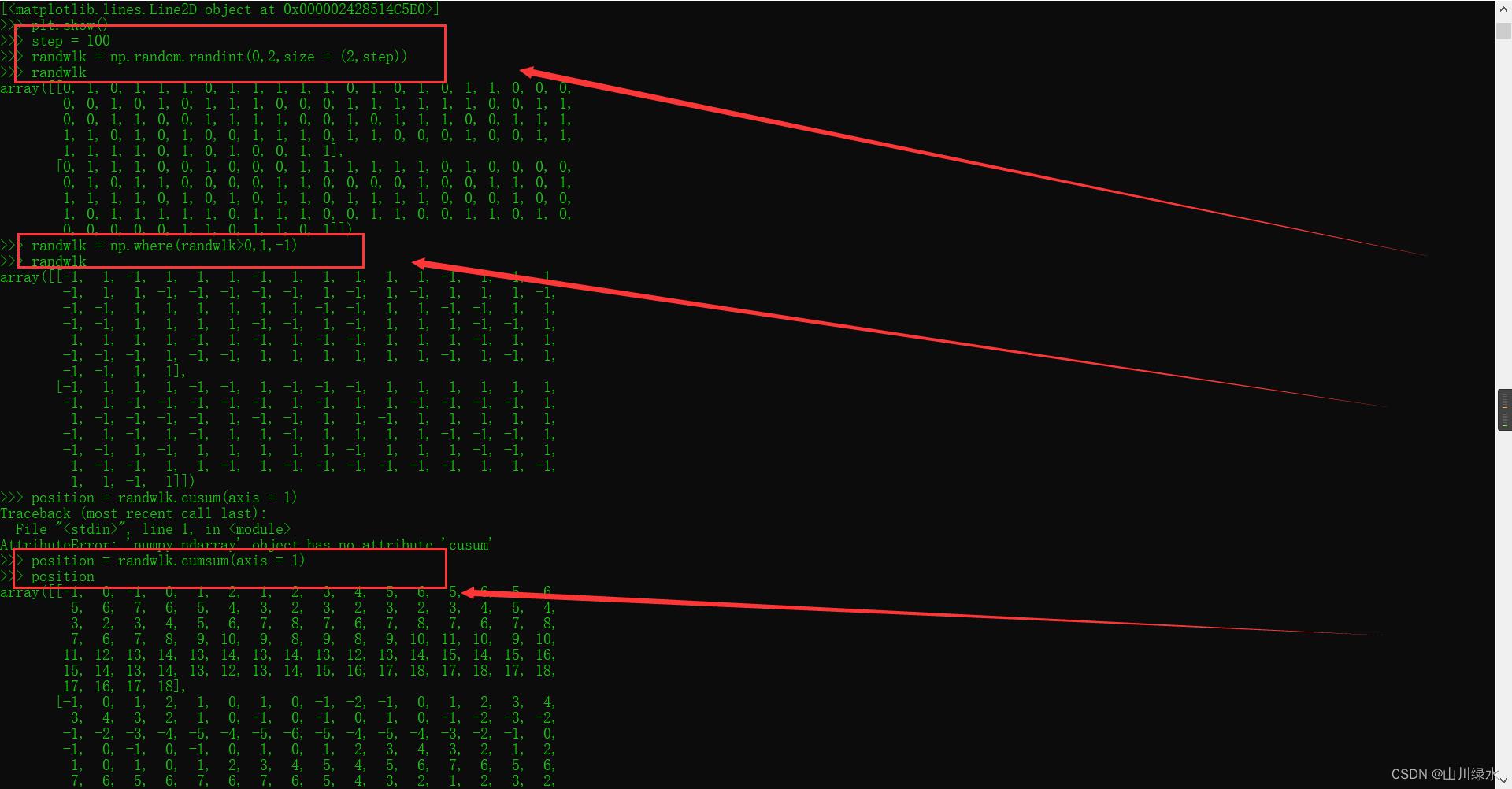
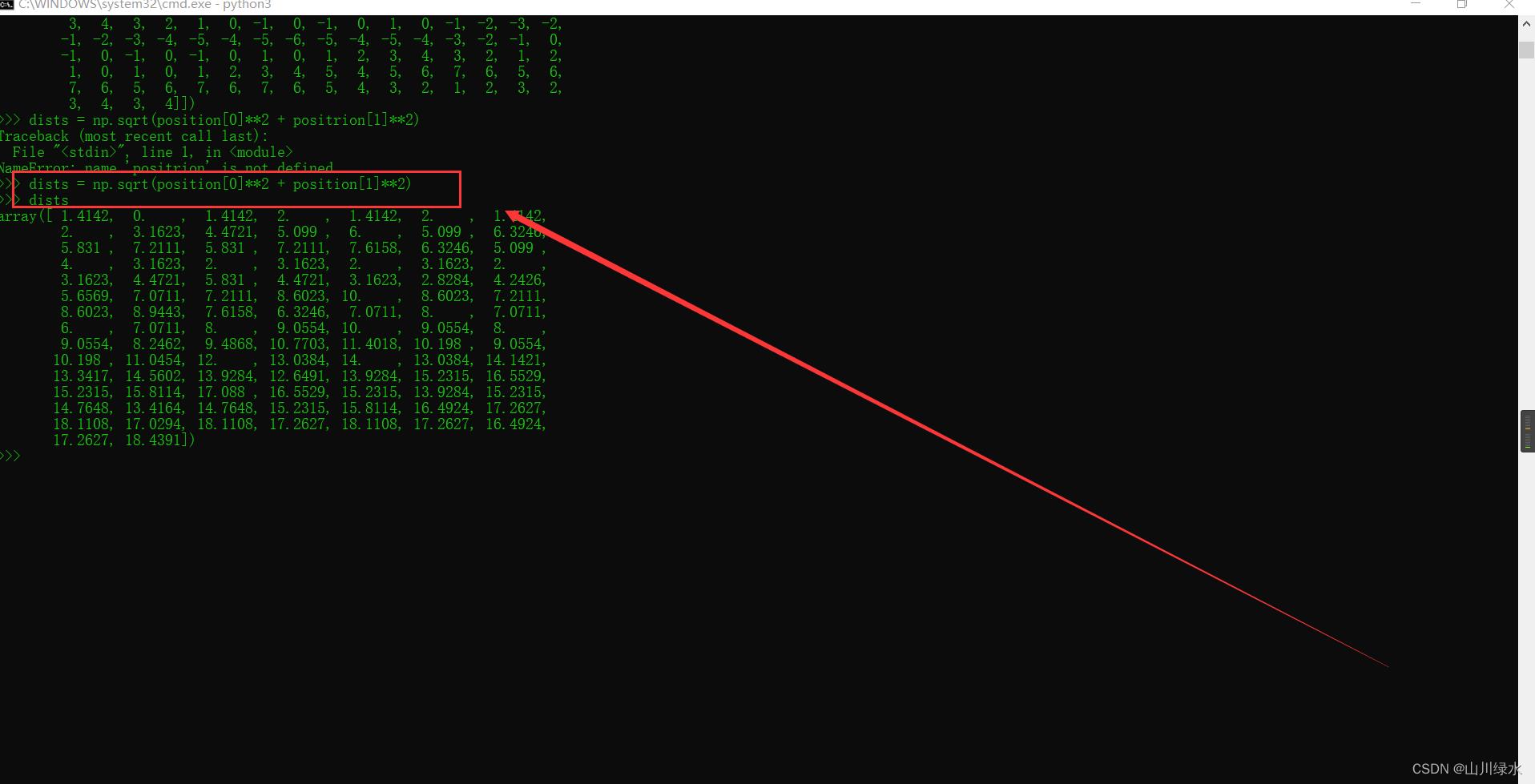
综合练习题
1.大润发、沃尔玛、好德和农工商4个超市售卖苹果、梨、香蕉、橘子和芒果5种水果。使用numpy的ndarray实现以下功能。
(1)创建两个一维数组分别存储超市名称和水果名称。
>>> import numpy as np
>>> fruit = np.array(['苹果','梨','香蕉','橘子','芒果'])
>>> sup = np.array(['大润发','沃尔玛','好德','农工商'])
>>> sup
array(['大润发', '沃尔玛', '好德', '农工商'], dtype='<U3')
>>> fruit
array(['苹果', '梨', '香蕉', '橘子', '芒果'], dtype='<U2')
>>>

(2)创建4 x 5的二维数组存储不同超市的水果价格,其中价格(单位为元)由4~10范围内的随机数生成。
>>> price = np.random.randint(4,11,size = (4,5))
>>> price
array([[ 4, 7, 7, 7, 6],
[ 4, 8, 4, 4, 4],
[ 7, 9, 10, 7, 9],
[ 8, 7, 5, 8, 4]])
>>>

(3)选择大润发的苹果和好德的香蕉,并将价格增加1
sup == '大润发'
fruit == '苹果'
temp = price[(sup == '大润发')|(sup == '好德'),(fruit == '苹果')|(fruit == '香蕉')]
print(temp)
a = price[(sup == '大润发')|(sup == '好德'),(fruit == '苹果')|(fruit == '香蕉')] + 1
print(a)
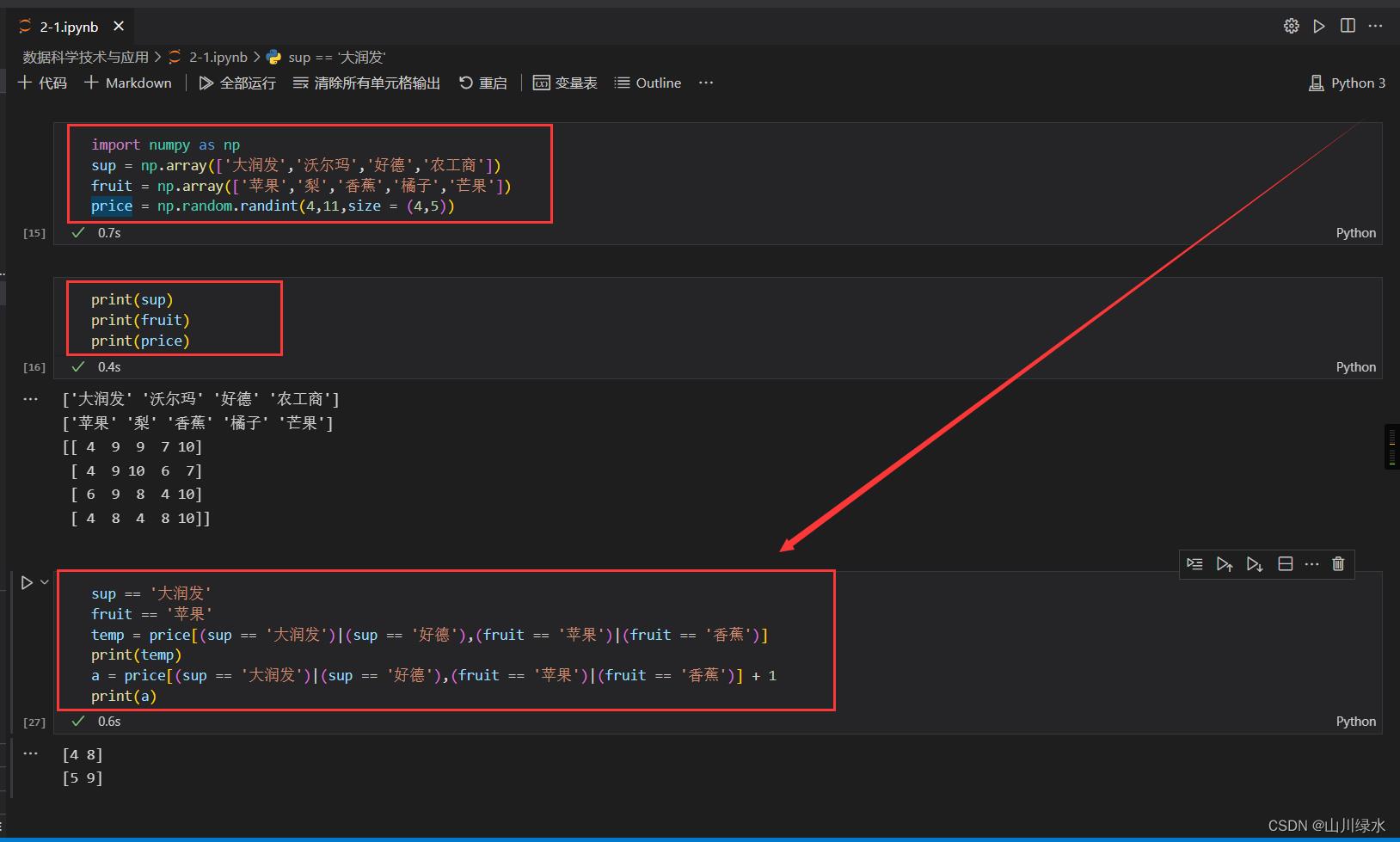
(4)农工商的水果大减价,将所有的水果价格减少2元。
temp = price[sup == '农工商']
print(temp)
print(temp-2)
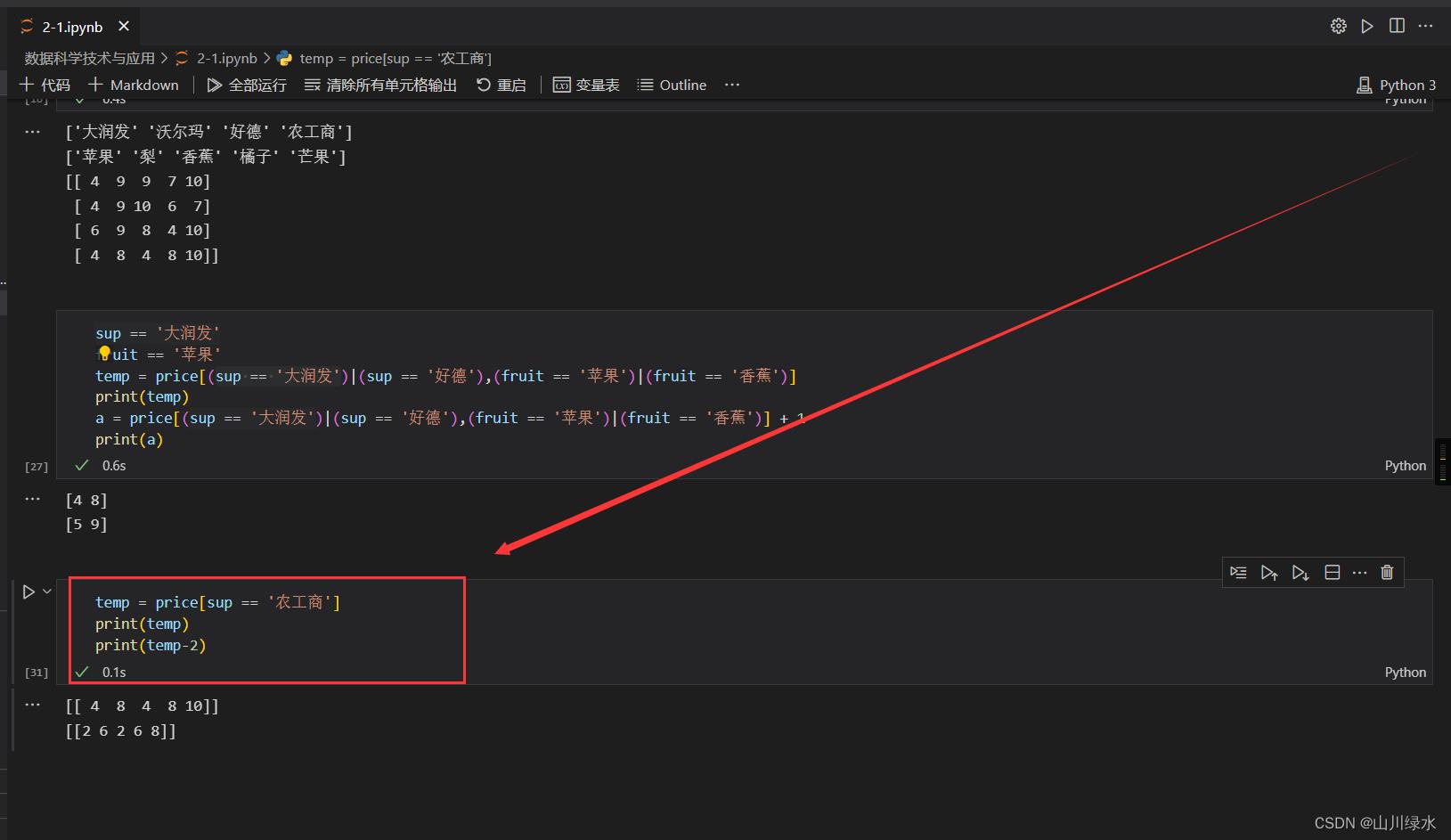
(5)统计4个超市苹果和芒果的销售均价
price[sup == '大润发',fruit == '苹果']
price[sup == sup[0]]
for i in range(0,4):
print(price[sup == sup[i],(fruit == '苹果')|(fruit == '芒果')].mean(axis=0))

(6)找出橘子价格最贵的超市名称(不是编号)
temp = price[:,fruit == '橘子'].argmax()
print(sup[temp])
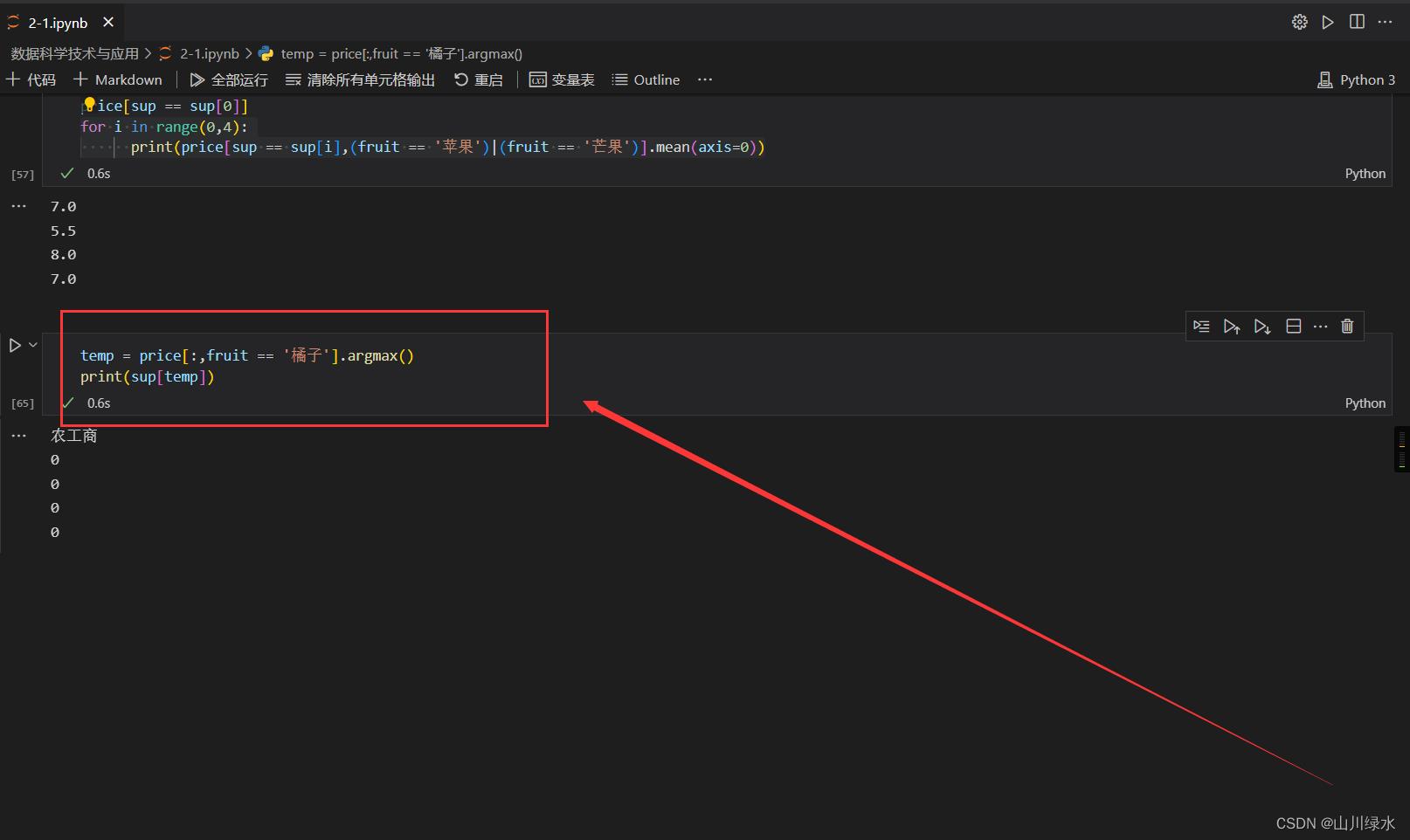
2.基于随机游走的例子,使用ndarray()和随机数生成函数模拟一个物体在三维空间游走的过程。
(1)创建3 x 10的二维数组,记录物体每步在三个轴上的移动距离。在每个轴向的移动距离服从正态分布(期望为0,方差为1)。行序0、1、2分别对应x轴,y轴、z轴。
temp = np.random.normal(0,1,size = (3,10))
temp

(2)计算每步走完后物体在三维空间的位置。
position = temp.cumsum(axis=1)
position
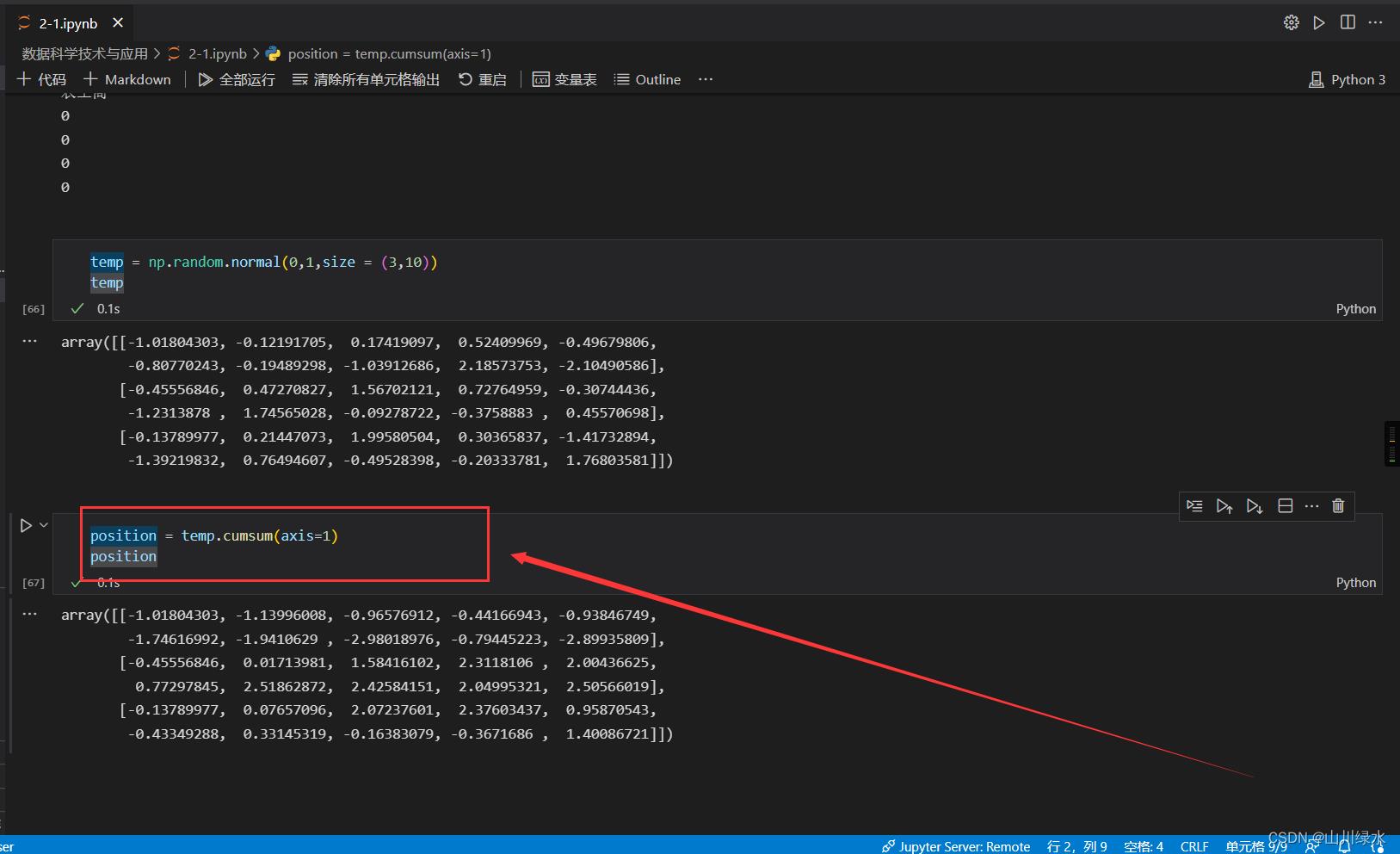
(3)计算每部走完后物体与原点的距离(只显示两位小数)
dists = np.sqrt(position[0]**2+position[1]**2+position[2]**2)
np.set_printoptions(precision=2)
dists

(4)统计物体在z轴上到达的最远距离。
max_dist = abs(position[2]).max()
max_dist
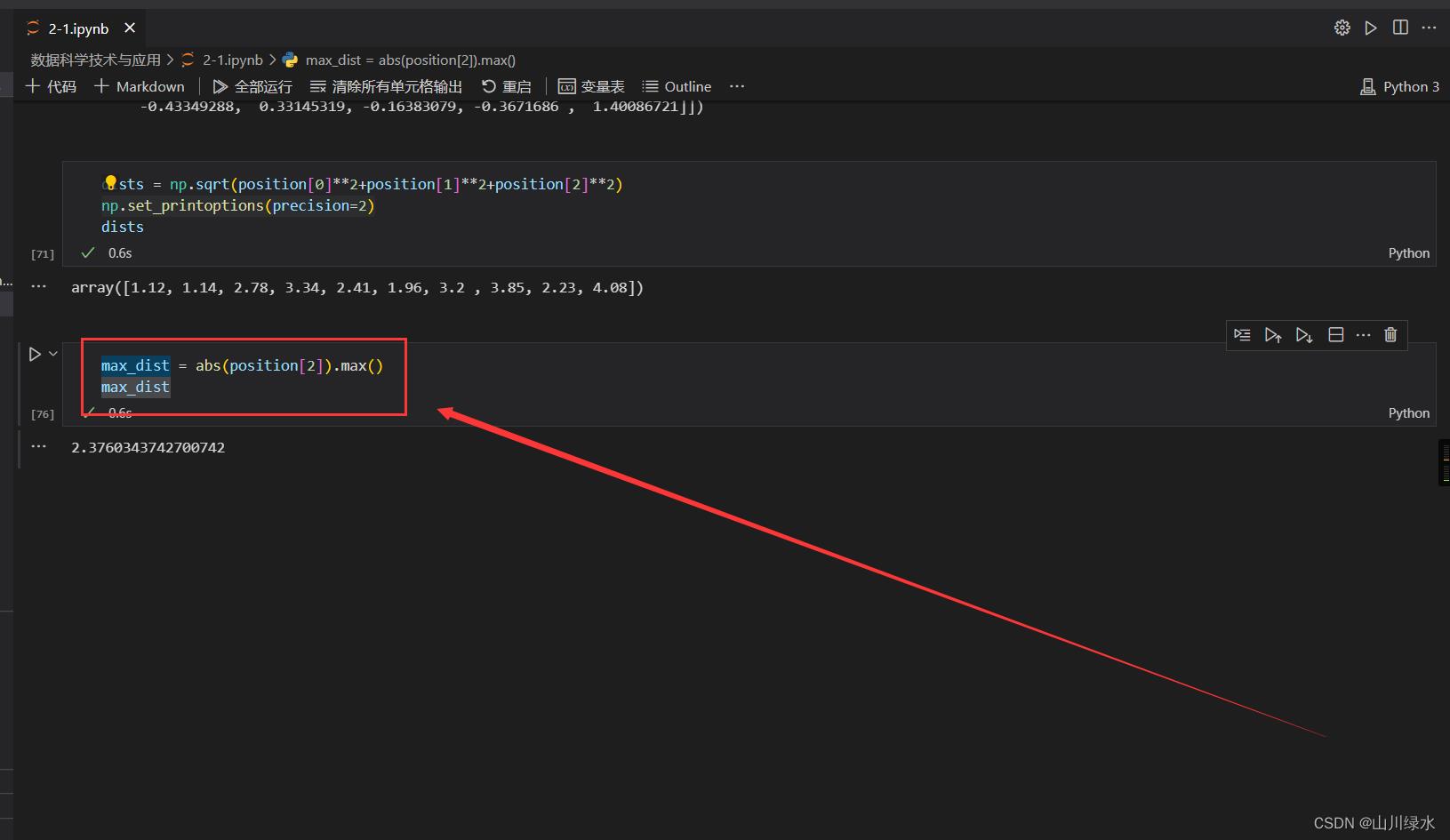
(5)统计物体在三维空间与原点距离的最近值
dists = np.sqrt(position[0]**2+position[1]**2+position[2]**2)
np.set_printoptions(precision=2)
dists.min()
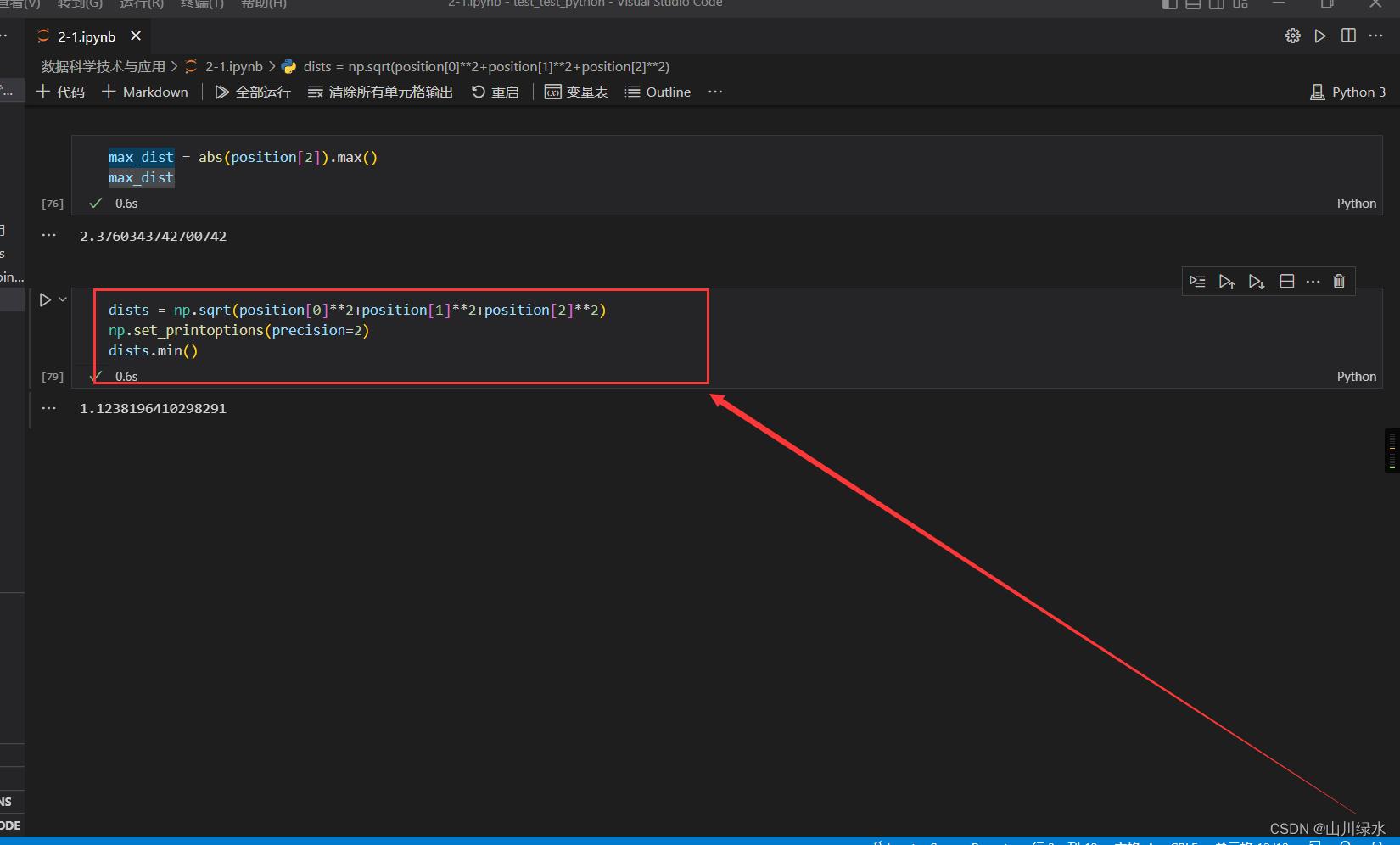
以上是关于多维数据结构与运算的主要内容,如果未能解决你的问题,请参考以下文章